
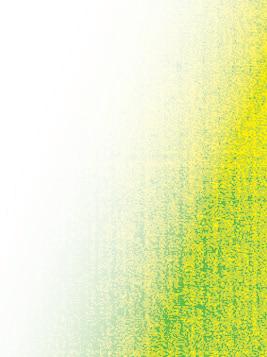
FALL 2022 MEMBERS’ MAGAZINE
We had a very special guest visit us back in May. Artist Takashi Murakami came by to kick off the planning for a major exhibition of some of his newest work, organized by our museum and scheduled to go on view exclusively here in the fall of 2023. Stay tuned to these pages to learn more, including how to get early bird tickets for members.
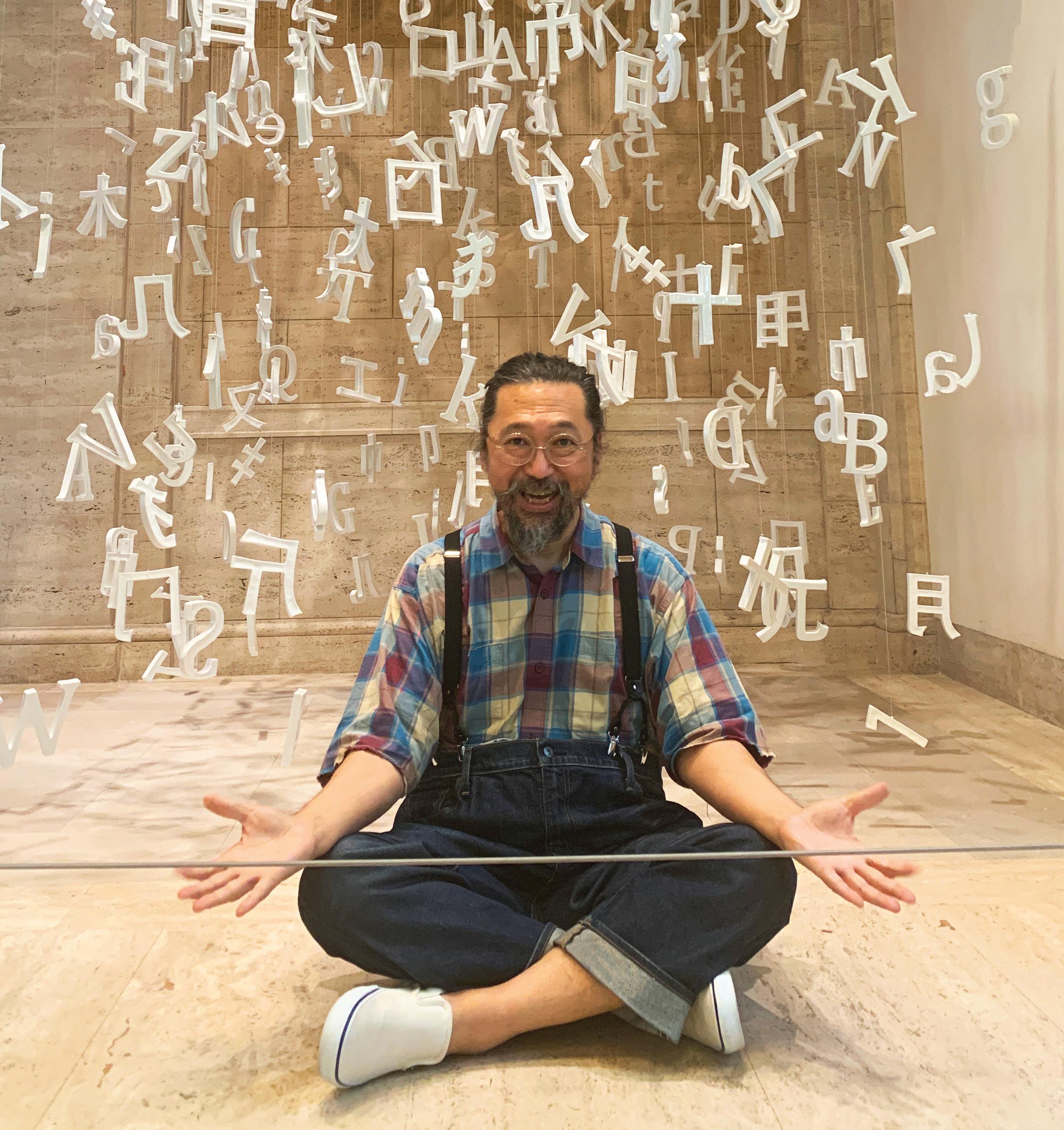
SURPRISE!
Published by the Asian Art Museum

Chong-Moon Lee Center for Asian Art & Culture 200 Larkin Street, San Francisco, CA 94102 415.581.3500 | asianart.org
Copyright © 2022 Asian Art Museum of San Francisco
Fall is a period traditionally marked by welcoming new seasons of cultural activities, expressing heartfelt thanks, and celebrating with family and friends. And that’s just what we do in this issue.

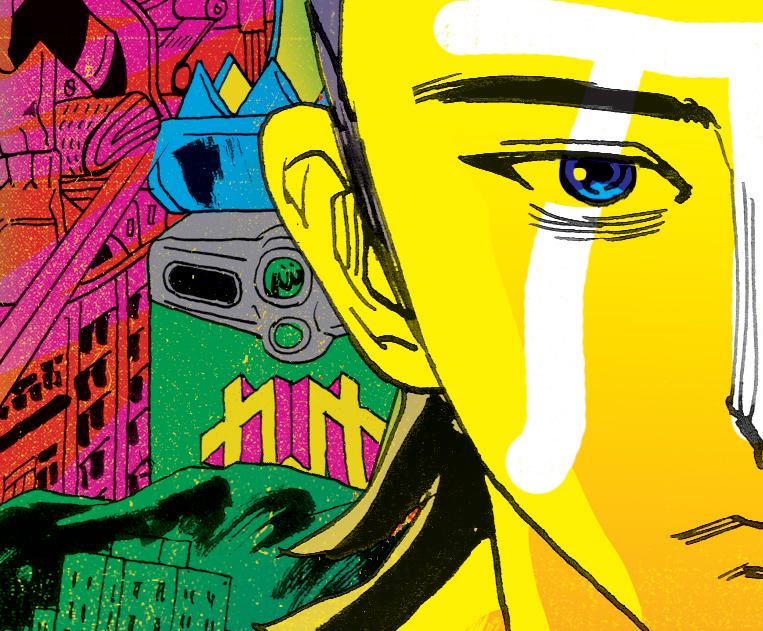
We’re celebrating our new strategic plan (page 2), a road map for the next stages of the museum’s growth. A key objective is to build upon the success of experience-centered exhibitions, like last year’s teamLab: Continuity. Our latest exhibition, Kongkee: Warring States Cyberpunk — part comic book, part motion picture, and part meditation on history repeating itself — is a prime example of this commitment.
Generous individuals and groups are helping us gain momentum. Grace Kase, and the Connoisseurs’ Council, among others, are committing support to expand meaningful experiences to our communities. Learn more on the following pages and join me offering thanks and gratitude.
We’re also thankful for the in-person return of our Japanese New Year Bell-ringing Ceremony. Please join me and family and friends on Dec 31 to celebrate our accomplishments, say farewell to the past year, and welcome the possibilities that lie ahead. n

SEE YOU AT THE MUSEUM!
Jay Xu
 THE BARBARA BASS BAKAR DIRECTOR AND CEO
THE BARBARA BASS BAKAR DIRECTOR AND CEO
6 18
IN THIS ISSUE
FALL 2022 VOL. XI ISSUE 2 Members’ Magazine
THE DIRECTOR CONTENTS Editor-in-Chief Tim Hallman Art Director Julie Giles Writers / Editors Kristina Youso / Nina Lewallen Hufford Director of Membership Danielle Hobart Museum Photographer Kevin Candland Additional photography Eric Martinez MAGAZINE STAFF Museum News Exhibitions Recent Acquisitions Education & Public Programs Membership Cha May Ching Boutique Society for Asian Art Scene at the Asian Event Calendars FALL 2022 1 12 2 6 17 20 24 28 29 30 32 20
Cover: The Singer (detail), 2018, by Kongkee (Kong Khong-chang 江記; b. 1977, active Hong Kong and London). Artwork and image courtesy of the artist and Penguin Lab. Copyright © 2018 the artists. Back cover: The Tears (detail), 2020, by Kongkee (Kong Khong-chang 江記; b. 1977, active Hong Kong and London). Artwork and image courtesy of the artist and Penguin Lab. Copyright © 2020 the artists.
FROM
MOVING FORWARD
It’s hard to read headlines from across the globe and not feel a sense of uncertainty about where things are headed. Trying to gain certainty where we can, the museum has adopted a strategic plan, carefully developed by museum leadership and staff over the past year, outlining objectives to guide the museum’s growth and development through 2027. These objectives include enhancing:
n Accessible collections and research
n Experienced-centered exhibitions and public programs

n Digital productions
n Satisfied/repeat visitors
n Sustainable operations
... All infused with our commitment to DEAI values.
This strategic framework is a roadmap for organizational planning, fundraising, budget development, and resource allocation. The next step — currently underway — is to define the outcomes for each of the objectives. Rigor and discipline will be guiding principles, providing a confidence to navigate through any challenges ahead, but more importantly, to ensure we continue to be of service to art, artists, and our communities. We’ll keep you apprised of our progress in the pages of this magazine, hoping you’ll continue to support and participate in this evolution. n
MUSEUM NEWS
Photograph © Asian Art Museum.
2 ASIAN ART MUSEUM
WHEN FLOWERS BECOME ART
They’re back! Our striking floral arrangements greeting visitors to Bowes Court — put on hold during the pandemic — have returned. Many thanks to the creativity and commitment of the museum’s Flower Committee, a group of volunteers trained in ikebana, the art of Japanese flower arranging. The designs on view are in the style of the modern Sogetsu School whose motto is: “anyone, anytime, anywhere, with any material.” Skilled attention to line, mass, and color are foundational principles of Sogetsu, combining a personal flair expressed in unique sculptural forms.
Our dedicated committee members have been creating ikebana at the museum for more than twenty years. Members are professional designers, Sogetsu teachers, and long-term practitioners with 10 to 60 years of experience. Each week, on a day when the museum is closed, a group of two or three from the committee will meet early at the San Francisco Flower Market to choose blooms, branches, and other material for that week’s arrangements. Special attention is paid to the quality and freshness of flowers, and of course the museum’s conservators take the precautionary step of inspecting the flowers to make sure they’re free of pests.

At the museum, the previous week’s arrangements and their containers are cleaned, while the fresh flowers are placed in water. Next, the vases for new creations are selected from a collection which has been built up over the years, drawing from both Japanese and local ceramicists. Then the designers set to work, together or solo, depending on the overall concept, which will touch on the season’s materials at hand. A card placed by each arrangement identifies the flowers used, and the artist(s) whose creations enliven the museum experience and bring joy to all our visitors. Take a moment to enjoy these creations on your next visit. n
Left:


MUSEUM NEWS
Recent arrangement by the museum's Flower Committee. Photograph © Asian Art Museum.
FALL 2022 3
POSITION NAMED IN HONOR OF AN INSPIRING SAN FRANCISCAN




Earlier this year, the museum received an extraordinarily generous gift from the KT Foundation that provides ongoing funding for the museum’s educational programs and honors the memory of Grace Kase, a remarkable San Franciscan. The foundation’s initial donation of $100,000 to the For All Campaign in 2021, earmarked for education, was followed this spring by a $3 million gift to endow the position of Grace Kase Director of Interpretation and Learning at the Asian Art Museum.
“The generosity of Grace Kase and the KT Foundation will help us transform lives and inspire inquisitive and creative minds for years to come,” says The Barbara Bass Bakar Director and CEO Dr. Jay Xu.
The KT Foundation was established by Grace Kase (1926–2019), who was born in Utah and grew up in San Francisco’s Japantown neighborhood. The family escaped forcible relocation and imprisonment — the fate of other Japanese American families living on the West Coast — by moving back to Utah in 1942, shortly after the signing of Executive Order 9066.
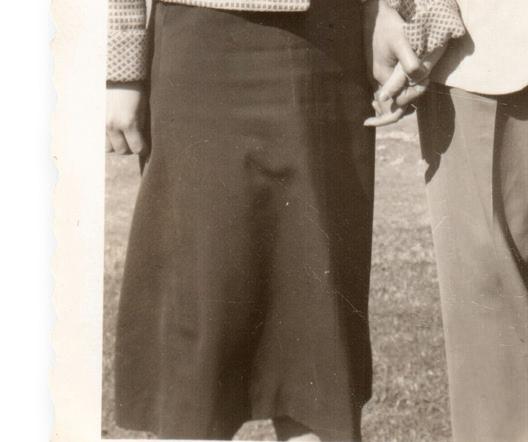



After the end of World War II, Grace returned to San Francisco. Imbued with her father’s entrepreneurial spirit and inspired by an



Italian American neighbor who was a realtor, a rare example of a woman in that profession in the 1940s, Grace decided on that career path for herself. “When Grace, a Japanese American woman, received her realtor’s license, she was a ‘unicorn,’” says her nephew, Mark Tsujimoto.

A go-getter by nature, Grace soon established herself in the industry, despite facing obstacles. Her business cards used only her first initial, to obscure her gender, and she often pronounced her last name with a long ‘a’ and silent ‘e’ to make it sound less Japanese. But her language skills — she was bilingual — made her a popular agent for Japanese American families looking to buy homes in the city.


Even though she faced discrimination as a professional Asian American woman, she never gave up. “Grace liked tough situations, she thought they brought out the best in her,” says Tsujimoto. As a businesswoman, she relished challenges and didn’t mind taking risks, character traits that also came out on her gambling trips to Reno and her afternoons playing mah jong at the Japanese American Community Center.
In the late 1950s, Grace began buying medium-sized




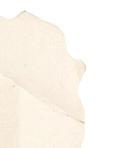

MUSEUM NEWS 4 ASIAN ART MUSEUM
apartment buildings in the city, managing them with her husband, Harry Tsujimoto. The couple had met at a YMCA dance and married in the early 1950s. Harry, who earned his M.S. in plant physiology from UC Berkeley, worked as a research scientist in a lab at Cal for 30 years and helped his wife manage the buildings on nights and weekends.
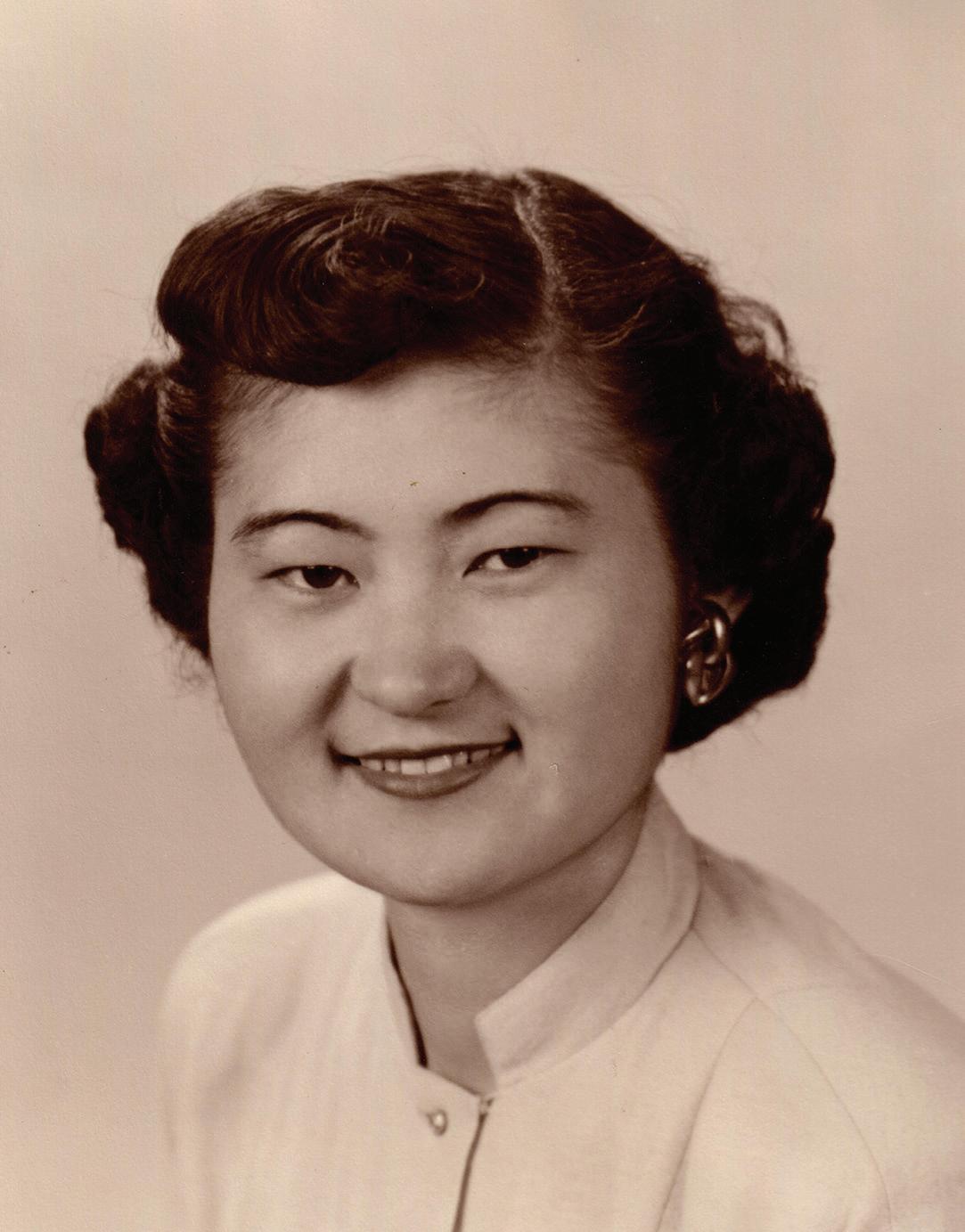
The KT Foundation’s gift to the Asian Art Museum honors Grace’s love of her native city. “She adored San Francisco,” says Tsujimoto. “She loved the diversity, the vibe, the food, the weather. She felt blessed to be a part of the San Francisco community and wanted to give back.”
Grace liked the idea of supporting the museum’s education and community outreach programs. “She was a small ‘d’ democrat and felt that museums should be accessible to all,” says Tsujimoto. “She was anti-elitist, so funding educational programs and community outreach fits perfectly with her beliefs.”
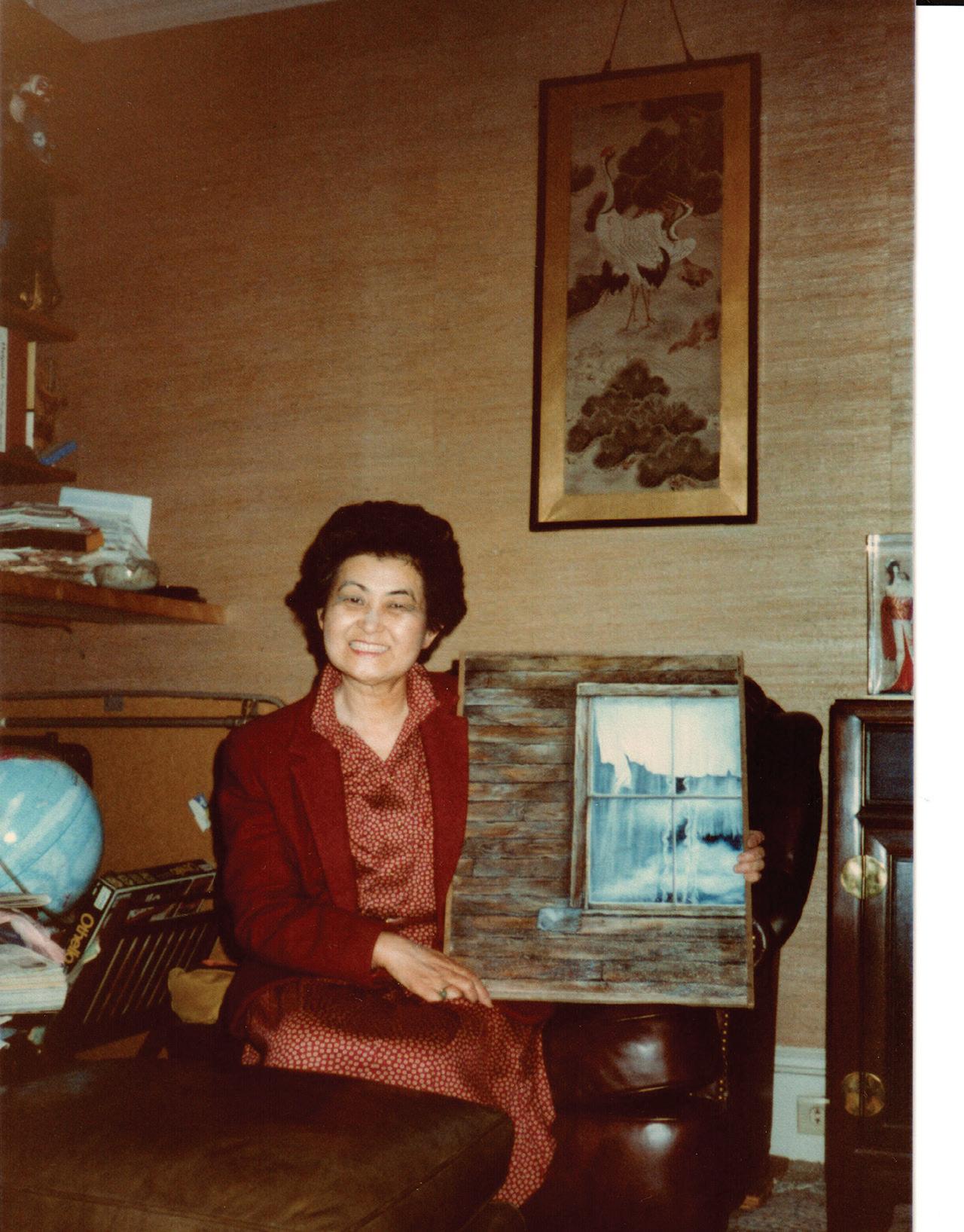
A lifelong amateur painter, Grace was also enthusiastic about supporting the arts. She spent more time on her own art in in later years, participating in an Art for Elders program offered at her retirement community. That program was so meaningful to her


that she contributed to Art to Elders so that they could expand their programs to low-income senior centers.
Other beneficiaries of Grace’s philanthropic generosity include veterans (she and her husband volunteered for many years at the San Francisco VA Medical Center at Fort Miley), Japanese American organizations, and UC Berkeley. The KT Foundation also supports Canine Companions, a charity that trains dogs and gives them to veterans as service dogs, and Muttville, which cares for senior and abandoned dogs.

“Grace Kase is an inspiration,” says Deborah Clearwaters, the first Grace Kase Director of Interpretation and Learning at the Asian Art Museum. “Although I never had the honor to meet her, her life story is like that of many of the artists the museum celebrates through its educational programming, collecting, and exhibitions. With Grace as our example, our team of educators will continue to work tirelessly on community impact and enjoyment.” ■

MUSEUM NEWS
FALL 2022 5
Photos of Grace Kase though the years courtesy of the Kase Family.
 Kongkee: Warring States Cyberpunk is organized by the Asian Art Museum of San Francisco. Presentation is made possible with the generous support of the Barbara Bass Bakar, HSBC Bank USA, and Diane B. Wilsey.
Kongkee: Warring States Cyberpunk is organized by the Asian Art Museum of San Francisco. Presentation is made possible with the generous support of the Barbara Bass Bakar, HSBC Bank USA, and Diane B. Wilsey.
NOV 18, 2022–JAN 23, 2023 AKIKO
EXHIBITIONS 6 ASIAN ART MUSEUM
Sustained support is generously provided by the following endowed funds: Akiko Yamazaki and Jerry Yang Endowment Fund for Exhibitions, Kao/Williams Contemporary Art Exhibitions Fund, and James M. Gerstley Fund for International Exhibitions.
YAMAZAKI AND JERRY YANG PAVILION
On November 18, 2022, an experiential art historical fantasia makes its North American debut. Appearing only at the Asian Art Museum, Kongkee: Warring States Cyberpunk travels back to the future in an immersive, genre-bending, futuristic odyssey more than 2,000 years in the making. Part comic book, part motion picture, part meditation on history repeating, the multisensory experience of Kongkee: Warring States Cyberpunk traces the legendary Chinese poet Qu Yuan’s soul on a journey from the ancient Chu Kingdom to an imagined 21st-century Asia of cyborgs, popstars, and surprising romantic reunions. The exhibition will occupy the museum’s Akiko Yamazaki and Jerry Yang Pavilion, which opened in 2021 with a blockbuster exhibition by digital collective teamLab.
In Warring States Cyberpunk, visitors step into a luminous series of animated vignettes — projected upon walls, ceilings, and screens and traverse a sound installation and animation theater space. The exhibition also features galleries of Kongkee’s art sketched in response to age-old Chinese artworks from the museum’s collection that are presented in the show. These objects include bronzes and jades from the eponymous Warring States Period (c. 481–221 BCE) and earlier, a time when China emerged into history with the founding of the Qin empire.
Exhibition curator Abby Chen, the museum’s head of contemporary art, explains that Kongkee initiated this project “by researching and allegorizing the historical figures of the Warring States period, allowing the artist to share how the past haunts the present, but also makes space for imagining what a vibrant strain of ‘Asian Futurism’ can look and feel like, one full of energy, music, and color.”
The exhibition centers on the migratory soul of the poet Qu Yuan (c. 339–278 BCE) who drowned himself in a river, and whose legacy carries on in the famous Dragon Boat races and festivals that are lively features of Chinese communities the world over. The artist recounts, “I asked myself, what happens when a soul emerges after 2,000 years under water — does it seek out something new? Does it return to places that are familiar? Qu Yuan’s poetry has a psychedelic, wandering quality to the language that I tried to reflect in my art, but I also wanted him to reflect the disorientation as well as the hope of our era.” In the resulting neon-soaked dreamscape, a resurrected android version of Qu Yuan struggles with memories; the dualities of death and immortality, body and soul; and what it means to be human.
Kongkee, a.k.a. KONG Khong-chang, (b. 1977, Chinese) was born in Malaysia, raised in Hong Kong, and is currently based in London. An award-winning animation director and multimedia visionary, he has worked in genres including comics, music, and film and is renowned for graphic novel-style imagery and immersive projections. His distinctive and groundbreaking work has been exhibited and published in Asia, Europe, and North America, and even caught the eye of iconic Britpop band Blur, who engaged with Kongkee to produce a comic book centered on their hit 2015 album “The Magic Whip.”

EXHIBITIONS
FALL 2022 7
Left: Dragon’s Delusion—Departure poster, 2017, by Kongkee (Kong Khong-chang 江 記; b. 1977, active Hong Kong and London). Artwork and image courtesy of the artist and Penguin Lab. Copyright © 2017 the artists. This page: Star Guitarist, 2022, by Kongkee (Kong Khong-chang 江記; b. 1977, active Hong Kong and London). Artwork and image courtesy of the artist and Penguin Lab. Copyright © 2022 the artists.
TAIHU ROCK—EAST WIND II
Last fall, we let you know that a new sculpture would soon grace Osher Plaza in front of the museum’s main entrance on Larkin Street. After some unforeseen delays, artist Tianjin Ren’s Taihu Rock — East Wind II, has now been installed, adding to the reawakening of Civic Center public spaces.

Cast from nickel silver, “Taihu rock” refers to the limestone formations found in Lake Tai in China’s Jiangsu province, traditionally one of the main sources for scholar’s rocks, watereroded stones that have been prized by Chinese scholars since the Tang dynasty (618–907).
Ren (b. 1962), a student of calligraphy at the China Academy of Art and researcher at the Modern Calligraphy Research
Center in Hangzhou, updates the refined art of traditional Chinese calligraphy by marrying it with the scale and brio of outdoor metal sculpture. Shaped to resemble cursive Chinese calligraphy spelling out “east wind” (dongfeng, 東風), the 8-foottall sculpture breaks from its two-dimensional written origins into three dimensions like an illustration in a pop-up book. This phrase references a Chinese idiom that encourages total preparation, in case a critical element is missing: “Everything is ready except the east wind.” Stop by for a closer read on your next visit. n
EXHIBITIONS
8 ASIAN ART MUSEUM
Taihu Rock—East Wind II, 2018, by Tianjin Ren (American, b. 1962). Nickel silver. Asian Art Museum, Gift of the artist, F2019.40.
THE ART OF CHINESE LACQUER
Known for its elegant forms and lustrous surfaces, Chinese lacquer is an ancient art form that evolved over thousands of years. Delightful Luxury: The Art of Chinese Lacquer features highlights from the museum’s superb collection of Chinese lacquer, including court accessories, scholars’ objects, luxury items, and household furniture. Twenty-seven objects span the Western Han (206 BCE–9 CE) to the Republic of China (1912–1949) periods, exemplars of technique, innovation, and extravagance across millennia of change.
Lacquer is created from the sap of a tree native to southern China and was originally applied as a protective finish for wood. Later, artisans used lacquer to form ornamental surfaces, with thick layers that could be carved into relief patterns or inlaid with decorative elements. High-quality lacquerware is precious because of the skill, time, and expense it requires to produce.
Over centuries, a range of lacquer techniques developed along three distinct paths: surface painting or drawing, carving, and inlay. In early China, lacquer was decorated with painted images or patterns. Charcoal and cinnabar were used to color the lacquer black or red, respectively. By the eighth century, craftsmen mastered techniques of attaching appliqués of metal leaf and inlaying gilded silver wires and mother-of-pearl. In subsequent eras, tastes favored engraved layers of alternating lacquer colors and complex patterns in three-dimensional carving to produce dazzling surfaces. Popular motifs included imperial and auspicious symbols associated with good luck, longevity, and prosperity.
With their unique beauty and extravagant cost, traditional lacquerwares were highly demanded as luxury objects, serving as diplomatic gifts, exported goods, and dynastic treasures. From a Western Han–period (206 BCE–9 CE) cosmetic box set to Qing- and Republic-era luxury objects and household items of grandiose display, Delightful Luxury fascinates the eye and pleases the mind, while inviting the viewer to look closely and marvel at the artists’ finely honed techniques.
Exhibition highlights include a Southern Song-period (1127–1279) cosmetic box with surface engravings of dragons symbolizing the imperial clan and prosperity, while a lotus-shaped box with tray and cover from the Yuan (1271–1368) recalls the organic forms of earlier ceramics and metalware. A rectangular tray with landscape design from the Ming dynasty (1368–1644) is a virtuoso example of mother-of-pearl inlay, whose literati-style landscape evokes ancient painting masters and literary culture. From the era of the Qianlong emperor (1736–1795), prolific collector and patron of the arts, is a table screen and stand of carved multicolor lacquer on wood. Layered color patterns form auspicious religious symbols, while the screen’s inherent symbolic wordplay enhanced its appeal for display in a wealthy Qing household, and now, our museum.
Picnic Box, approx. 1800–1911. China. Lacquer and gold painting on wood and bamboo, plied and knotted silk cords. Asian Art Museum, Bequest of Michel D. Weill, B85M2. Photograph © Asian Art Museum.

EXHIBITIONS
OPENS NOV 17 TATEUCHI GALLERY
FALL 2022 9
COLOR TRIP
YOSHID A HOD A KA’S MODERN PRINTS
DEC 16, 2022–MAY 1, 2023 OSHER FOUNDATION GALLERY
Presented exclusively at the Asian Art Museum, Color Trip: Yoshida Hodaka’s Modern Prints brings together nearly 50 of this influential Japanese artist’s works in his first ever solo exhibition in the United States. Yoshida Hodaka (1926–1995), born into the celebrated Yoshida family of print artists based in Tokyo, was a pioneer and leader of post-war Japanese printmaking known for his surreal and abstract prints. Rebelling against the Yoshida family artistic style of realistic woodblock prints, Hodaka forged his own path, creating arrestingly colorful images through modern methods like photo etching and collage. His unique style of surreal landscapes and abstract forms was inspired by his globe-spanning journeys, photography, poetry, and ancient art, evoking the aesthetics of contemporaneous art movements that unleashed his creative process.
“Hodaka was a rebel in the best sense, someone who imagined a new way of seeing the world. By combining the centuries-old woodblock printing with the modern methods of photo etching and collage and contemporary influences like Pop art and foreign travel, Hodaka opened up a new frontier in Japanese printmaking that was completely original to him,” says exhibition organizer Yuki Morishima, associate curator of Japanese art at the Asian Art Museum.
Early in his career, Hodaka was inspired by the mid-twentieth century sosaku hanga (creative print) movement, which promoted artistic self-expression and required that the artist perform all steps of producing a print himself. Hodaka created the design, carved the woodblocks, and carried out the printing, producing images that could be considered works of art rather than massproduced commercial products.
The artist’s collages from the 1960s and 1970s are filled with subtly linked objects comprising images that can also be “read” like poems. A published poet himself, Hodaka explained “Doing art... especially from my collage series onward, I merely substituted shapes for words. There is an almost exact correspondence.”
Exploring non-traditional woodblock printmaking techniques such as photo etching and lithograph, Hodaka opened new frontiers in Japanese printmaking.
Hodaka’s 1973 suite of 12 poster-size Zodiac Landscape prints will be on view together for the first time ever at the museum. As Morishima notes, “Hodaka playfully assembled and juxtaposed ordinary objects out of context, creating his surreal scenes with dreamlike atmospheres. Every time you look at these prints, you find something new and exciting hiding in the landscape.” These deeply imaginative works, bursting with color and astrological mystique, provided inspiration for the exhibition’s name.
Later work explores the collision of realism and abstraction. Comparing the original photographs of old buildings with the final composition of Storehouse in Tomo (1988), for example, reveals Hodaka’s sophisticated design sensitivity, draftsman skills, and refined photographer’s eye for detail. Prints of abstract shapes, collaged landscapes, and disintegrating forms point to the artist’s personal struggle to connect to the wider world through his creative practice.
The Asian Art Museum acquired Hodaka’s prints in 2016 directly from his daughter Ayomi, who is also an artist the museum has exhibited as recently as 2017. As part of Color Trip’s immersion into the Yoshida milieu, Hodaka’s sketchbooks will be presented for the first time in the United States. The exhibition will also feature more than a dozen artworks by Hodaka’s father (Hiroshi), his mother (Fujio), his brother (Toshi), his wife (Chizuko), and Ayomi, giving audiences an unprecedented opportunity to chart Hodaka’s changing course as an artist as well as his enduring connections to his family. n
Leo, from the series Zodiac Landscape (detail), 1973, by Yoshida Hodaka (Japanese, 1926–1995). Photoetching and woodblock print; ink and colors on paper. Asian Art Museum of San Francisco, Museum purchase, Thomas F. Humiston Acquisition Fund, 2016.28. © Yoshida Ayomi. Photograph © Asian Art Museum.
EXHIBITIONS
12 ASIAN ART MUSEUM

EXHIBITIONS FALL 2022 13

EXHIBITIONS
“I have made a path to my heart with Chinese calligraphy.”
10 ASIAN ART MUSEUM
BERNICE BING
BERNICE BING
Into View: Bernice Bing celebrates the museum’s recent acquisition of 20 works that shine a light on an important local Asian American artist who is largely unknown. These works survey the evolution of Bing’s remarkable practice, from paintings of the 1950s and 1960s that straddle Abstract Expressionism and figuration to work from the 1980s and 1990s that explore a synthesis of Zen calligraphy and Western modernism. The exhibition invites you to discover Bing’s distinctive achievement and admire her perseverance as an outsider — as a woman, an Asian American, and a lesbian — in the art world of the second half of the 20th century.
Born in San Francisco’s Chinatown in 1936, Bernice “Bingo” Bing (1936–1998) lost both of her parents at the age of five and spent her childhood bouncing between an orphanage and multiple foster homes. After graduating from Oakland Technical High School in 1955, she received a scholarship to attend the California College of Arts and Crafts (now CCA), where she studied with Richard Diebenkorn and Japanese painter and theorist Saburo Hasegawa. It was Hasegawa who introduced Bing to Zen Buddhism, Chinese philosophers, and traditional calligraphy. This may have been Bing’s first meaningful exposure to her Chinese cultural heritage. She then completed her B.F.A. and earned her M.F.A. at the California School of Fine Arts (now the San Francisco Art Institute or SFAI), where she studied with painters such as Elmer Bischoff and became enmeshed in the city’s Beat Era art scene.
A Lady and a Road Map, from 1962, with its broad planes of vibrant color and nearly recognizable abstract forms informed by both Abstract Expression and the Bay Area Figurative Movement, is a significant example of Bing’s early work. The following year, she moved to Napa County, and her paintings, while still nonrepresentational, evolved to focus on what she called “the overwhelming spirituality of nature.” This approach deepened in subsequent years as she delved into New Age spirituality and spent time at Esalen, the holistic retreat in Big Sur on the California coast.
Bing’s early commitment to abstraction evolved to incorporate references to her Asian heritage, including her Buddhist faith.
Her investment in social activism and community development included working to create a more inclusive environment for Asian American and other nonwhite artists. In the 1970s, she was involved with San Francisco’s Neighborhood Arts Program, which supported art-making in the city’s diverse neighborhoods, including Hunter’s Point, Chinatown, and the Mission. In the 1980s, Bing served as the first executive director of the South of Market Cultural Center (now SOMArts), which promotes the work of artists from underserved communities, and she was an early member of the Asian American Women Artists Association.
In the 1980s, Bing’s abstraction began to display the influence of her Buddhist practice and of traditional Chinese art. In 1984, she received a Fulbright scholarship to spend three months in China, where she studied calligraphy and traditional ink landscape painting. Her work following that formative trip evolved toward a synthesis of calligraphy and abstraction, and she often chose titles for her paintings that reference the Lotus Sutra.
Bing was diagnosed hemochromatosis and lupus in the mid-1990s; she died in 1998 from cancer. Her last major work, Epilogue (1990–1995), serves as a resume of her artistic development: abstract clusters, some suggesting figurative forms and others calligraphic sources, are arranged in a 24-foot-long linear composition that reads like the unrolling of a handscroll.
The museum is proud to provide a home for these works and to bring long overdue recognition to a pioneering Asian American artist. Into View: Bernice Bing is the first in an ongoing series of collection exhibitions championing the work of under-recognized modern artists. n
Into View: Bernice Bing is organized by the Asian Art Museum of San Francisco. This exhibition is made possible with the generous support of the Terra Foundation for American Art. Sustained support generously provided by the Akiko Yamazaki and Jerry Yang Endowment Fund for Exhibitions and the Kao/Williams Contemporary Art Exhibitions Fund.
A Lady and a Road Map (detail), 1962, by Bernice Bing (American, 1936–1998). Oil on canvas. Asian Art Museum of San Francisco, Museum purchase, 2020.26. © Estate of the Artist. Photograph © Asian Art Museum.
EXHIBITIONS
NOW ON VIEW
FALL 2022 11
HAMBRECHT GALLERY
LAM TUNG PANG
HISTORY, MEMORY, LANDSCAPE... AND BLOWTORCHES
DEC 16, 2022–SEPT 18, 2023 LEE GALLERY



























In a gallery-spanning installation, Hong Kong-based artist Lam Tung Pang synthesizes a millennium of Chinese, Korean, and Japanese nature scenes scaled up from the picture page to near life size. Exclusively at the Asian Art Museum, Past Continuous Tense (2011) gives audiences a chance to connect important works from historical masters, many in the museum’s collection, with an exploration of contemporary themes of global significance. After years of research at the Chinese University of Hong Kong’s New Asia College library, Lam (Chinese, b. 1978) carefully rendered selected ink paintings from great masters, including colophons (artists’ inscriptions or collectors’ stamps) onto 52 planks of simple plywood spanning 52.5 feet. Instead of ink and brush, however, he employed an extraordinary technique: blowtorch and charcoal to score the intricate drawings into the wood, overlain with ashes to recreate the gauzy effect of paint on silk.
Guest curated by Mia Yinxing Liu, Assistant Professor in the Department of Art History at Johns Hopkins University, Past Continuous Tense introduces audiences to layers of encounter and transmission: the natural world was first mediated through
— ABBY CHEN, HEAD OF CONTEMPORARY ART
past masters of ink painting, then re-mediated by a learned few into the art books and painting manuals that Lam drew from for this work.
Lam’s montage of artist historical references, rendered at a scale both intimate and lifelike, produces an arresting interactive experience with both history and nature, at once contemplative and problematic. The artist’s forest, created from canonical imagery of the past, invites reflection on our relationship to nature, our current era of ecological devastation, and the relationship between the virtual and the real. The use of fire on wood is a keen reference to the fragility of both our cherished artworks and lived natural environment.
Drawing its title from English grammar, Past Continuous Tense conveys an ongoing action that already took place, but perhaps one that continues to impact our present. “Lam’s work is both prophetic and nostalgic,” says Abby Chen, Head of Contemporary Art at the Asian Art Museum. “Past Continuous Tense reckons with issues of change in the name of a ‘progress’ whose benefits often raise more questions than they answer.”
EXHIBITIONS
Lam Tung Pang (Chinese, b. 1978, active Hong Kong) in his Hong Kong studio. Courtesy of the artist
“Lam’s work is both prophetic and nostalgic.”
14 ASIAN ART MUSEUM

EXHIBITIONS FALL 2022 15
From larger-than-life temple sculpture to paintings crafted for intimate viewing to immersive video works by contemporary artists, artworks from across South and Southeast Asia and the Himalayas have for millennia illuminated vital connections between movement, life, and the spirit. This exhibition will, for the first time in an American museum, invite audiences to experience the critical interplay between visual arts and dance in the Indian cultural sphere, from ancient rituals to the glamour of Bollywood. ■

Image: Dancing villagers (detail), approx. 1730. Attributed to Pandit Seu (Indian, 1680–1740). Opaque watercolors on paper. Los Angeles County Museum of Art, from the Nasli and Alice Heeramaneck Collection, Museum Associates Purchase, M.77.19.24.
 Beyond Bollywood: 2000 Years of Dance in Art is co-organized by the Asian Art Museum of San Francisco and the Cincinnati Art Museum. This exhibition has been made possible in part by a major grant from the National Endowment for the Humanities: Democracy demands wisdom. Additional support provided by Eliza and Dean Cash, Sumir Chadha, Vaishali Chadha and Family, Yogen and Peggy Dalal, Shashi and Dipanjan “DJ” Deb, Aarti and Sandeep Johri, Lata Krishnan and Ajay B. Shah, Fred Levin & Salle Yoo and Je Gray, Dipti and Rakesh Mathur, Sundar and Anjali Pichai, SACHI, Society for Art & Cultural Heritage of India, Ram and Vijay Shriram, Meena Vashee, and an anonymous donor.
Beyond Bollywood: 2000 Years of Dance in Art is co-organized by the Asian Art Museum of San Francisco and the Cincinnati Art Museum. This exhibition has been made possible in part by a major grant from the National Endowment for the Humanities: Democracy demands wisdom. Additional support provided by Eliza and Dean Cash, Sumir Chadha, Vaishali Chadha and Family, Yogen and Peggy Dalal, Shashi and Dipanjan “DJ” Deb, Aarti and Sandeep Johri, Lata Krishnan and Ajay B. Shah, Fred Levin & Salle Yoo and Je Gray, Dipti and Rakesh Mathur, Sundar and Anjali Pichai, SACHI, Society for Art & Cultural Heritage of India, Ram and Vijay Shriram, Meena Vashee, and an anonymous donor.
MAR 31–JUL 10, 2023 2000 YEARS OF DANCE IN ART Beyond Bollywood 16 ASIAN ART MUSEUM EXHIBITIONS
A THOUSAND THREADS
Vibrant colors, striking patterns, and sophisticated techniques mark a hundred-year-old collection of intricate Indonesian textiles recently acquired by the museum.
Between 1898 and 1937 the Dutch artist and ethnographer W.O.J. Nieuwenkamp traveled across the Indonesian archipelago. He produced two major volumes on the region, as well as numerous other publications. An early interest of Nieuwenkamp was textiles, and this collection of twenty-five remarkable examples reflects his fascination with the diverse traditions of this vast region.
Through the textiles, we can trace Nieuwenkamp’s journeys from the western island of Sumatra to the island of Leti in the east. He was the first Westerner to recognize the double ikat (geringsing) technique made only in the village of Tenganan in East Bali. The collection contains several fine examples each with different patterns (left). A colorful silk shoulder cloth from Palembang in Sumatra is made with a painstakingly complex tie-dye technique on silk (middle). Historically, the museum’s collection has been sparse in textiles from the eastern islands of Indonesia, and the Nieuwenkamp collection fills gaps with fine examples from Flores, West Timor, and Leti (right).
Some of the pieces in this collection were displayed in an exhibition in Paris in 1920, but most of these textiles have never been on public view. They were sold by Nieuwenkamp’s descendants to an American collector in the 1990s, where they remained until this year. We would like to extend our thanks to Walter Jared Frost, David Salman, M Glenn Vinson, Jr., and the Gladys K. Barber Endowment for making this acquisition possible. ■
Left: Woman’s chest cloth (kemben pelangi) (detail), 1928. Indonesia; Palembang, South Sumatra. Silk and natural dyes. Museum purchase, Gladys K. Barber Endowment; with additional funds from Walter Jared Frost and David Salman, and M. Glenn Vinson, Jr., R2022.13.3. Middle: Breast wrap with lotus flower motif (geringsing cemplong) (detail), 1904–1906. Indonesia; Tenganan, Karangasem, Bali. Cotton and natural dyes. Museum purchase, Gladys K. Barber Endowment; with additional funds from Walter Jared Frost and David Salman, and M. Glenn Vinson, Jr., R2022.13.14. Right: Shoulder cloth (semba) (detail), 1918. Indonesia; Ende, Flores. Cotton and natural dyes. Museum purchase, Gladys K. Barber Endowment; with additional funds from Walter Jared Frost and David Salman, and M. Glenn Vinson, Jr., R2022.13.19. Photographs © Asian Art Museum.


RECENT ACQUISITIONS FALL 2022 17
A GENERATION OF GIFTS
The recently acquired 18th-century painting, Maharana Sangram Singh II celebrating the Spring Festival with his nobles in the Rose Garden in Udaipur, features the ruler of the kingdom of Udaipur in a lush palace garden filled with pink roses. The king is joined by his garlanded courtiers to celebrate the coming of spring. Musicians play and dancers portraying the Hindu deity Krishna and his beloved Radha entertain but also offer a reminder of spiritual matters pertaining to divine love. This large and impressive painting invites us to imagine the multisensory delights of a rose garden, its lovely scents, the sounds of the rebab and singing, and the pleasures of cultivated company.

“Cultivated company” reflects the spirit of the museum’s Connoisseurs’ Council, first established in 1985. Scores of likeminded Asian art devotees joined together to provide financial
support for acquiring artworks to enhance the museum’s collection — and have a bit of fun doing it. Here’s how: the Council’s annual membership fees were pooled; then the museum’s curators were encouraged to “pitch” artworks to the Council — items available from reputable dealers, typically something that could fill a gap in a collection area and allow the museum to tell a richer or more complete story.
These pitches took the form of friendly competitions among the curators at the Council’s Acquisitions Dinner where, after hearing insightful descriptions of artworks and heartfelt pleas on why a particular item was worthy of the “cultivated company’s” support, the Council voted on which artwork to purchase with the pooled funds. That’s how the painting of Maharana Sangram Singh II made its way into the collection, just edging out an
RECENT ACQUISITIONS
18 ASIAN ART MUSEUM
18th-century portrait from Mongolia or China entitled The Qing Imperial Preceptor Changkya Khutuktu Rolpai Dorje, at the Council’s Annual Dinner this past July.
However, all good things must end. July’s annual dinner was the last for the Council, with the group ending its remarkable legacy of fellowship and generosity. Since its founding, the Connoisseurs’ Council has raised more than $4 million to help purchase fifty-seven artworks, including, among other highlights: a 16th-century Japanese painting of two gibbons by Shikibu Terutada; a pair of bronze Indonesian female and male ancestral figures dating from 1400–1600; a two-thousand-year-old


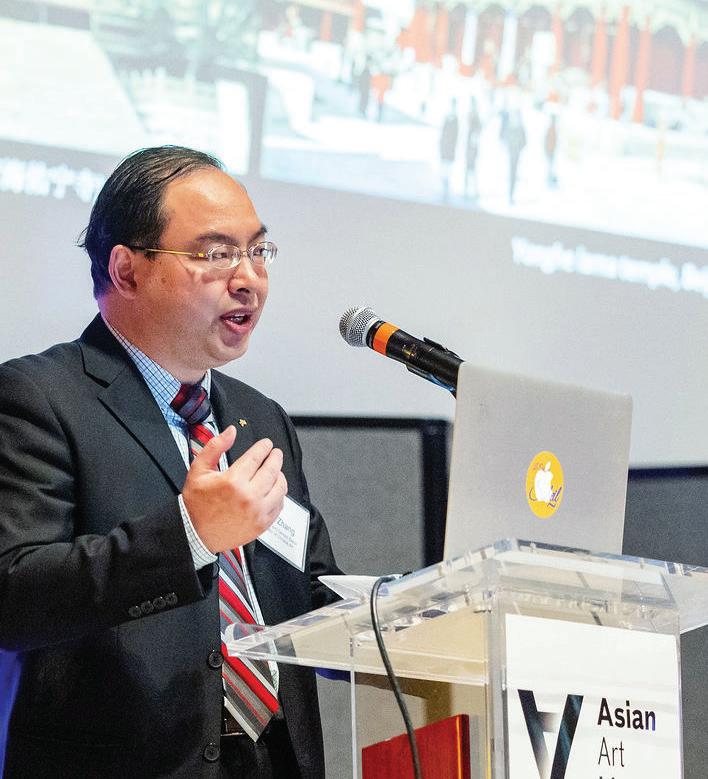
Chinese Han-period money tree; and an 18th-century Korean Joseon-dynasty jar. In some cases, the Council’s funds were augmented with other gifts — or to spark further generosity — working as a bolster for grander purchases.
The museum board, staff, scholars, and countless visitors are grateful for the Council’s generous partnership, which has forever enriched the museum, its collection, and the appreciation and connoisseurship of Asian art. Thank you, Connoisseurs’ Council, for making the collection — and the stories it shares — more diverse, deeper, and as unforgettable as a joyous festival in a jewel-tone garden.


RECENT ACQUISITIONS
FALL 2022 19
Left: Maharana Sangram Singh II celebrating the Spring Festival with his nobles in the Rose Garden in Udaipur (detail), approx. 1715–1720. India, Rajasthan state, former kingdom of Mewar. Opaque watercolor with gold on paper. Photograph © Asian Art Museum. Right: Connoisseurs' Council Acquisitions Dinner, July 26, 2022. Photographs by Katelyn Tucker.
JAPANESE NEW YEAR BELL-RINGING CEREMONY RETURNS ONSITE
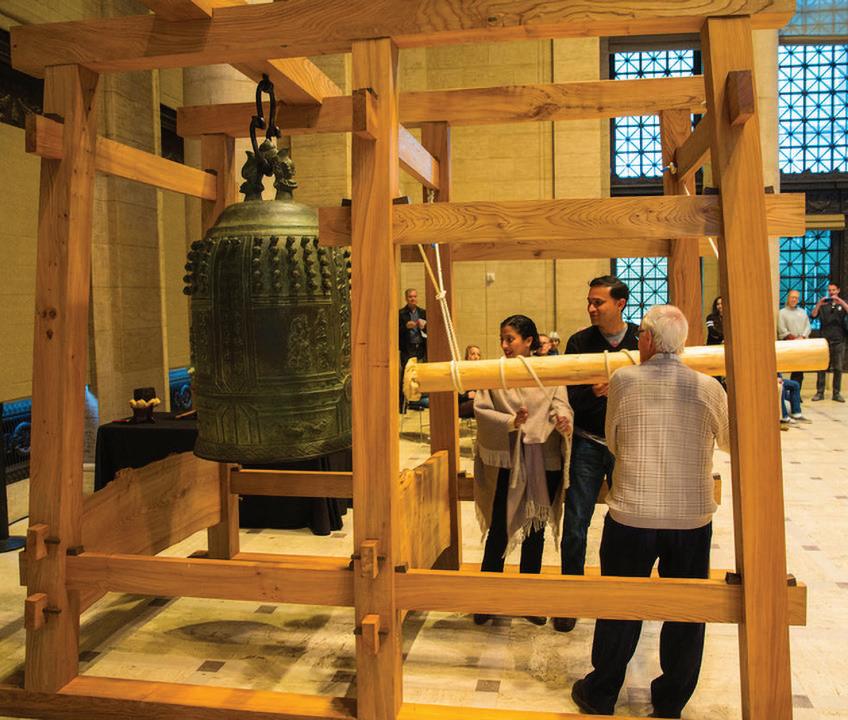
SATURDAY, DEC 31 SAMSUNG HALL
9:30 AM ceremony exclusively for members
11:30 AM ceremony for general public
After being held virtually for the past two years, our popular Japanese New Year Bell-ringing Ceremony returns onsite and in-person, and you’re invited to help us ring in the New Year — literally.

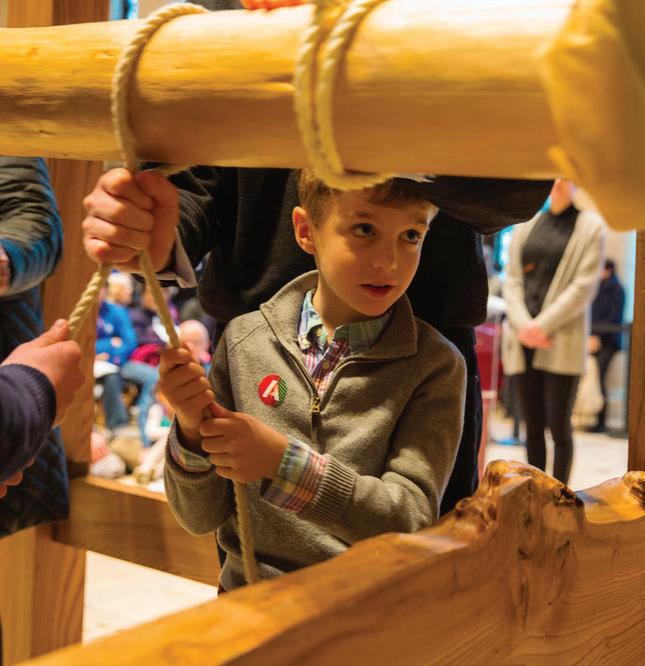
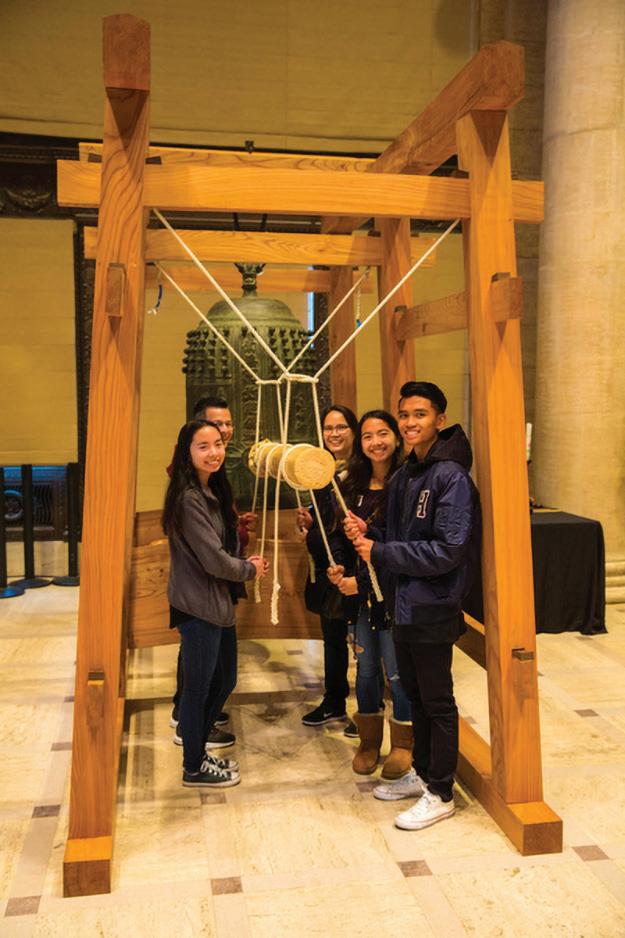
In Japan, the New Year is ushered in on Jan 1 with celebrations taking place on New Year’s Eve, including temples hosting bellringing ceremonies just before midnight. Following this tradition, we invite visitors to take a turn at ringing our 2,100-pound, 16thcentury Japanese temple bell 108 times to usher in the New Year and curb the 108 mortal desires (bonno) that, according to Buddhist belief, torment humankind. As you listen to each ring of the bell, imagine leaving behind the unfortunate experiences, regrettable deeds, or ill luck from the past year.
Reverend Gengo Akiba of Kojin-an Zen Center will officiate again this year, and there will be family-friendly hands-on activities throughout the day. A special tactile storytelling tour for visionimpaired guests is also available (pre-registration for this tour is required. Email awyckoff@asianart.org for details.)


Our ceremony is held during the morning of New Year’s Eve with one ceremony exclusively for members, followed by a second ceremony for the public. For more information, visit asianart.org. n
Photographs by Quincy Stamper.
EDUCATION
20 ASIAN ART MUSEUM
ART SPEAK 15 th ANNIVERSARY ENGAGING YOUTH, TRANSFORMATIONAL IMPACT
As is true with many cultural organizations, teenagers are the lowest-attending demographic at the Asian Art Museum. Fifteen years ago, in conjunction with the 2007 Osamu Tezuka: Marvel of Manga exhibition, the museum’s Education Department initiated the Art Speak high school internship to create opportunities for youth involvement in the museum. For a six-month period, interns focused on exhibition tours and interpretation, and creating visitor activities.
Today, Art Speak is a year-long teen internship program that focuses on learning and exploring Asian art and culture, social justice and youth activism, and career opportunities in museums and the arts. As part of the museum’s commitment to expanding equity in the arts, the internships have always been a paid opportunity.
Reflecting on the collective political and pandemic trauma of 2020, last year interns created the Art Can Speak, Art Can Heal installation in the Koret Education Center Windows, choosing collection objects and creating their own zines and art pieces.
Recent interns describe the value and transformational impact that the Art Speak program has had on their lives, studies, and career trajectories. Samya Brohmi, 2014–2015 intern, states that the program solidified her “commitment to preserving art history and furthering public accessibility to art.” She will pursue a Master’s in Library and Information Science in the coming year.
For Sophia Shen, a 2019–2021 intern, Art Speak awakened a shift from STEM studies to the pursuit of humanities, and “a deeper interest in social justice and education.” She is currently majoring in Ethnic Studies at UC Berkeley.
Currently a PhD candidate in medical science, 2015–2017 intern Ahab Chopra shares how the experience deeply affected his understanding of the “interconnectedness of art and science, and the centrality of art to lived experience."

Information about the Art Speak program can be found at about.asianart.org/art-speak/, and on Instagram: instagram.com/artspeakinterns. n
The Asian Art Museum's Art Speak Program is generously supported by the Dhanam Foundation; John Sell; and The Sato Foundation. General support for education is provided by the Dhanam Foundation; The William K. Bowes, Jr. Foundation Education and Research Fund; James C. Hormel and Michael P. Nguyen; The Hearst Foundations; Dodge & Cox; and The Joseph & Mercedes McMicking Foundation. Support is also provided by an endowment established by The Hearst Foundations. Image: Art Speak interns gather virtually with Triana Patel, manager, Youth & Family Public Programs. Photograph © Asian Art Museum.
EDUCATION
FALL 2022 21
EMPHASIS ON ACCESS
Education for all is essential to the Asian Art Museum’s mission. That's why everyone working in visitor-facing roles works hard every day to engage with diverse audiences — of every age, ability, and learning style — across a multitude of communities throughout the Bay Area and beyond.
As part of this commitment, and to better reach underserved audiences, the Education team recently organized the museum's first-ever Access Day, held on March 28. With the goal of making the museum more welcoming and accessible to people with disabilities, the event included a range of new and previously prototyped experiences, including hands-on components that featured “tactile experiences” with materials such as textiles.
American Sign Language (ASL) interpretation was also provided for visitors, and the museum premiered an ASL orientation video created for guests who are Deaf or hard of hearing. Large-print labels and audio tour content were available for blind and low-vision visitors (always available on request as well). Staff across departments helped ensure the day’s success, with more than 60 guests participating and offering feedback about how to integrate accessibility elements into the museum experience more broadly. Community partnerships with Lighthouse for the Blind and Blind Posse were essential to the implementation of the program.
Launching last April, the museum’s original ASL digital tour of its celebrated masterpieces has been free via the museum’s mobile app as well as on YouTube. The tour was produced in close consultation with Sam Sepah, who works as a lead accessibility research product manager in Silicon Valley and provided expertise in accessibility best practices as they intersect with digital technology. Members of the Bay Area Asian Deaf Association (BAADA) and Linda Bove, who played the beloved Deaf librarian from 1971 to 2002 on “Sesame Street,” were also key participants in developing the new tour.
“Launching the ASL tour with the museum’s masterpieces made sense, since they light a pathway through a large, extremely diverse collection, meaning Deaf adults and children can enjoy the museum in an equitable way,” says Sepah, who also coordinated casting and input from the Deaf community.
He continues, “This tour underscores for everyone the fundamental pleasures of visiting a community hub like the Asian Art Museum but does so on visitors’ own terms and in a style that matches their needs, opening up new opportunities for lifelong learning for all.”
Recent innovations by department educators have also advanced accessibility for English language learners, and for students with learning disabilities. Selected tours are accompanied by CART captioning, where tour content is transcribed in real time to enhance student comprehension through direct engagement. CART, Communication Access Realtime Translation, is a tool that particularly serves the Deaf and hard-of-hearing communities. This functionality is available for both live and virtual tours.
A helpful assist for English language learners has been to provide slides (displayed on iPads) to accompany gallery tours and the exhibition of artworks. Slides include images as well as text. For example, if English learners are asked the question, “How did the artist create the moon?”, a slide might be presented with the text “The artist created the moon by...” to guide students to reflect on the material and respond with confidence. Other slides assist with the comprehension of language by displaying images with vocabulary words.
These techniques help all learners who need time to process information, not only students still learning English. Asian Art Museum educators have developed these offerings in collaboration with a museum Teacher Advisory group, and by partnering with SFUSD Access, a disability advisory group of the San Francisco Unified School District. By working directly with the disability and education communities, the museum’s education team continues to expand the ways the collections and exhibitions are made as accessible and uplifting as possible for visitors of all backgrounds and all abilities. n
General support for education is provided by the Dhanam Foundation; The William K. Bowes, Jr. Foundation Education and Research Fund; James C. Hormel and Michael P. Nguyen; The Hearst Foundations; Dodge & Cox; and The Joseph & Mercedes McMicking Foundation. Support is also provided by an endowment established by The Hearst Foundations. Images: Visitors at the first-ever Access Day event, March 28, 2022. Photographs © Asian Art Museum.
EDUCATION
22 ASIAN ART MUSEUM
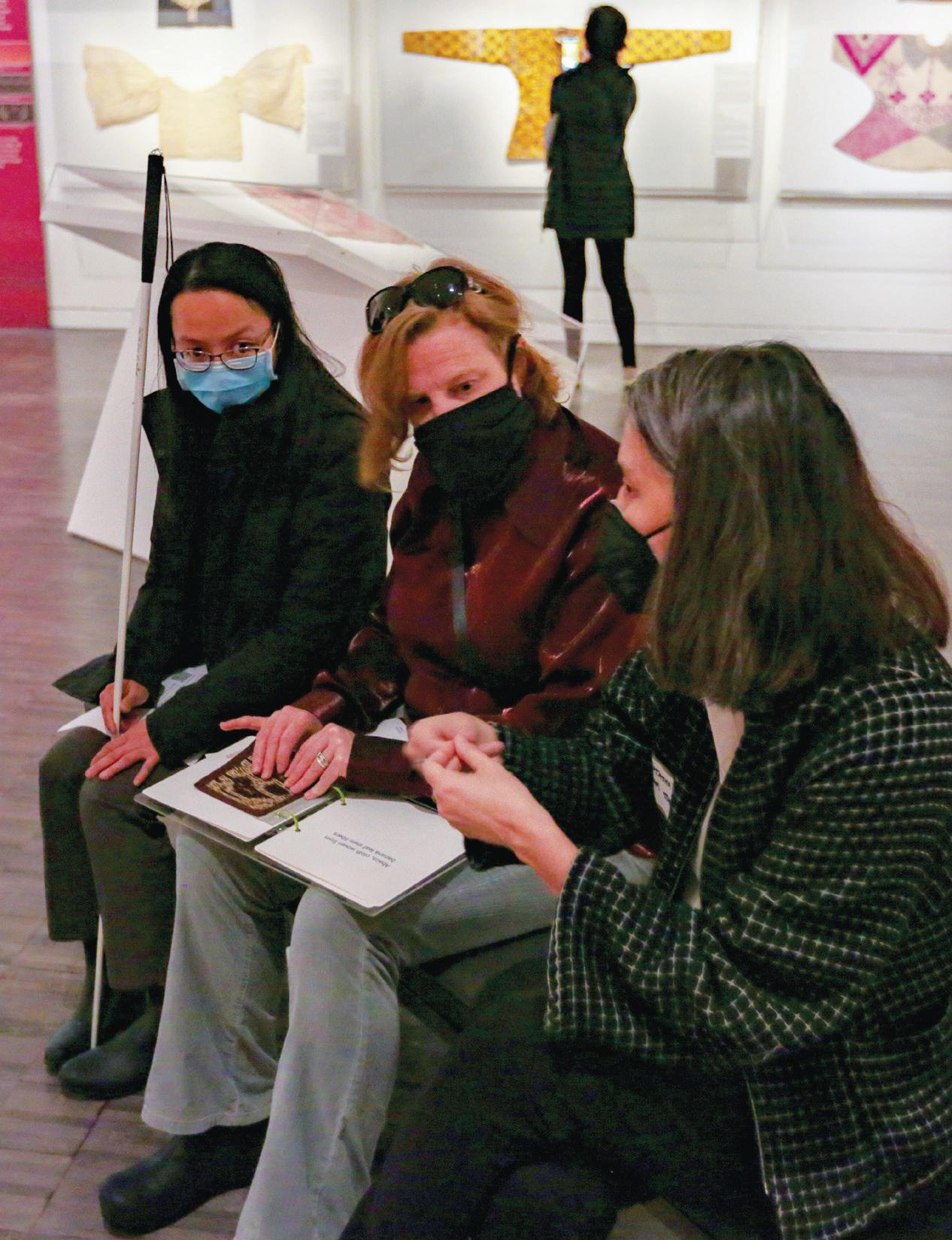
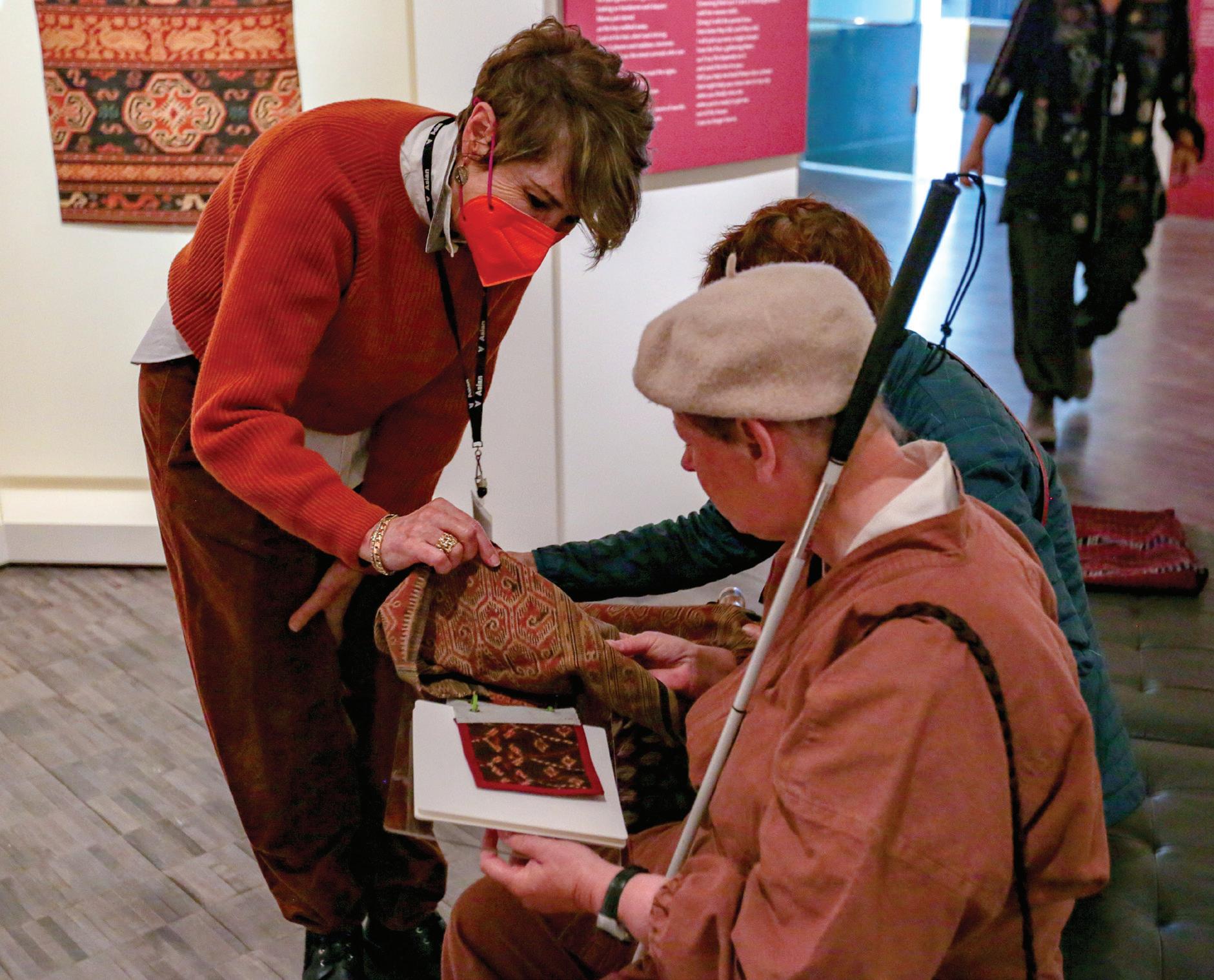

EDUCATION FALL 2022 23
MEET GUMP SOCIETY MEMBERS
DAPHNE AND STUART WELLS, SENIOR MEMBERS SINCE 2015
“When we were dating years ago, we often went to the Metropolitan Museum in New York, basking in the aesthetic qualities of the Frank Lloyd Wright room, discovering the power of simplicity, calmness, and value of materials. When we first encountered Asian art at the Asian Art Museum’s former home in Golden Gate Park, we felt this excitement again, sparking a lifelong connection to the arts and cultures of Asia.
Rather than an occasional source of entertainment, we view the museum as a significant community resource, actively engaging us all in not only aesthetics, but issues of social importance, sparking a deeper appreciation of diverse cultures, helping us understand the world and our place in it. This, especially evident in the museum’s programs for young people, is why we support the museum through our membership, and why
we are making a legacy gift to continue these esential efforts into the future.
We are grateful that we can be part of the museum’s ongoing evolution, offering rich experiences to onsite visitors, and, via digital means, to the global community.” n
Join Stuart and Daphne Wells by making a gift to the museum in your will or by beneficiary designation to ensure that your legacy at the Asian Art Museum lives on for future generations. Contact Kate McNulty, Director of Individual and Legacy Giving, at 415.581.3683 or kmcnulty@asianart.org for more information.

MEMBERSHIP
24 ASIAN ART MUSEUM
Photographs © Asian Art Museum.
JADE CIRCLE PROFILE
MIDORI AND PAUL ANTEBI
Q: Tell us a little about you and your family.
Midori and I met in Houston, Texas. We soon got married, having ceremonies in the U.S. and Japan, and then moved to Southeast Asia, adding daughters in Bangkok and Singapore before moving to the Bay Area in 2008.

Q: How did you become interested in Asian art? It’s an interest that continues to develop but really got rolling when Midori served as a docent at the National Museum of Bangkok, at the Asian Civilisation Museum, Singapore, and at the Singapore Art Museum. We love finding treasures on travel adventures, like discovering items at the Dirt Market in Beijing, Chatuchak Market in Bangkok, Augustine’s in Yangon, and Tanglin in Singapore.
Q: Describe your connection to the Asian Art Museum. We were proud to serve as members of the Asian Art Museum Council, a group of young art enthusiasts assembled to help the museum foster a new generation of supporters. Our daughters grew up in the museum galleries and developed a deep connection to their Asian roots by attending the Once Upon a Time family events. It remains a wonderful way to spend time with friends and family including our favorite neighbors from Bangkok, Patrice and Michael Wilbur. The museum never fails to inspire us and we’re always excited to see what’s cutting edge in art, in culture, and even in science!
Q: Why do you support the museum as a member of Jade Circle Gold?
Promoting and celebrating Asian art and culture in the Bay Area, and beyond, is a core part of who we are as a family.
Q: What do you like about being a Jade Circle member? It’s a great way to continue to learn more about the places in Asia our family is from and has lived in, and doing so in the company of friends, artists, and scholars is deeply meaningful and somehow manages to always be unique. n
Step into the Jade Circle for a deeper experience of Asian art and culture. Enhance your museum experience with insider access while supporting the museum and its programs. Contact Kate McNulty, Director of Individual and Legacy Giving, at 415.581.3683 or jadecircle@asianart.org for more information.
MARK YOUR CALENDAR
Jade Circle Gold Trip to Boston
With Curator of Japanese Art Dr. Laura Allen
Early May 2023
Interested in joining the trip?
Email jadecircle@asianart.org.
MEMBERSHIP
FALL 2022 25
THE POWER OF THE MOVING IMAGE

Since Ding Huan’s prototype for the zoetrope in 180 CE, moving images have captured our attention and sparked our imaginations. Today, with nearly limitless options for how to spend “screen time,” the Asian Art Museum offers unique film events that enhance audience experience of the museum, including exhibitions and collections, and also celebrate Asian and Asian American stories and creativity. Patron- and Friend-level members are invited to attend these specially curated film events throughout the year. For upcoming programs visit the online calendar at asianart.org or email us at members@asianart.org.
Scan the QR code or visit asianart.org/filmsurvey to participate in a brief survey and help shape our film events this year.

REINA
RAISING EMPATHETIC INNOVATIVE NEW ARTISTS








Did you know? The amazing benefits of art are essential for children. Early engagement with museums and hands-on art making builds skills like problem solving, observation, and empathy, and bolsters a child’s self-esteem. Through activity guides, storytelling tours, and art-and-crafts workshops, we invite you to learn, play, and make art together as a family.
Learn
more online at give.asianart.org or call 415.581.3740.
Add Rhino Club to any membership level for $50. Learn more online at give.asianart.org or call 415.581.3740.









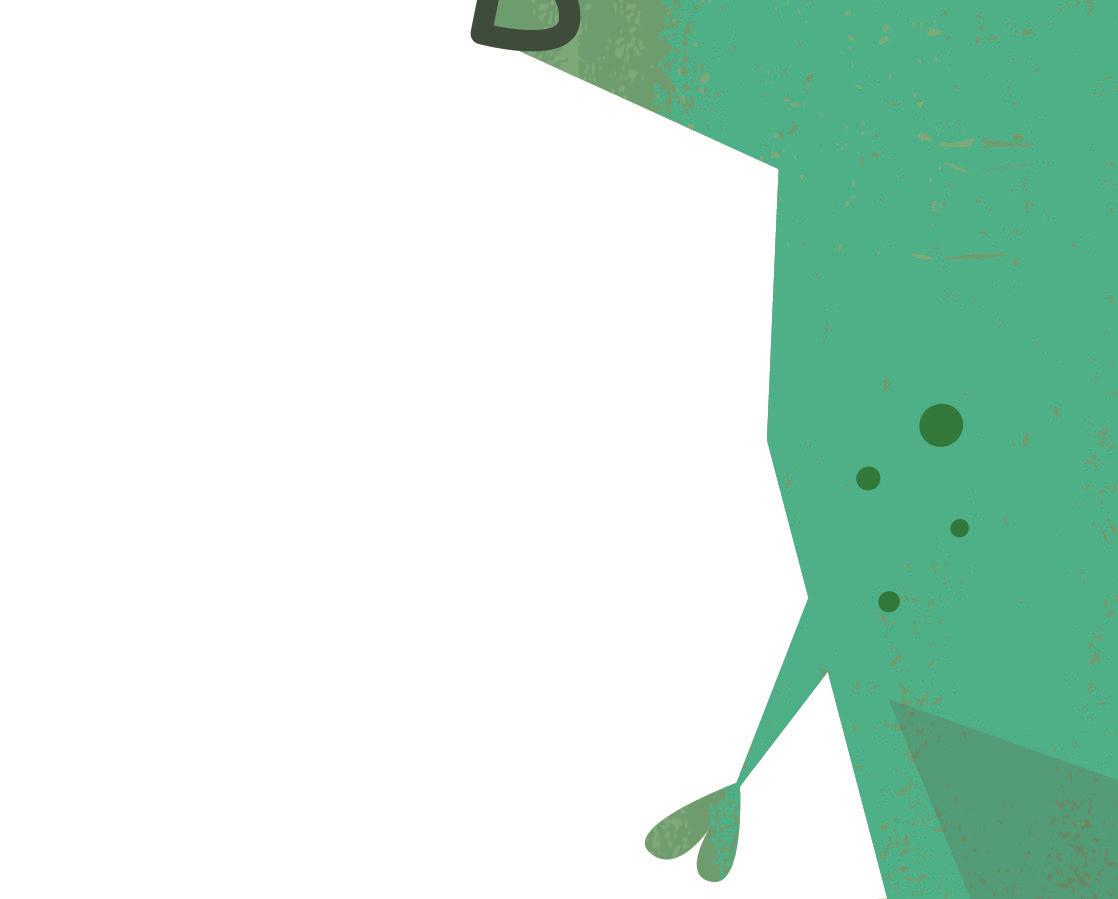


MEMBERSHIP
26 ASIAN ART MUSEUM
UNFORGETTABLE ART STARTS WITH YOU!
Your fully tax-deductible Museum Fund gift allows us to engage global audiences with the full richness and complexity of Asian and Asian American experiences, histories, and traditions.
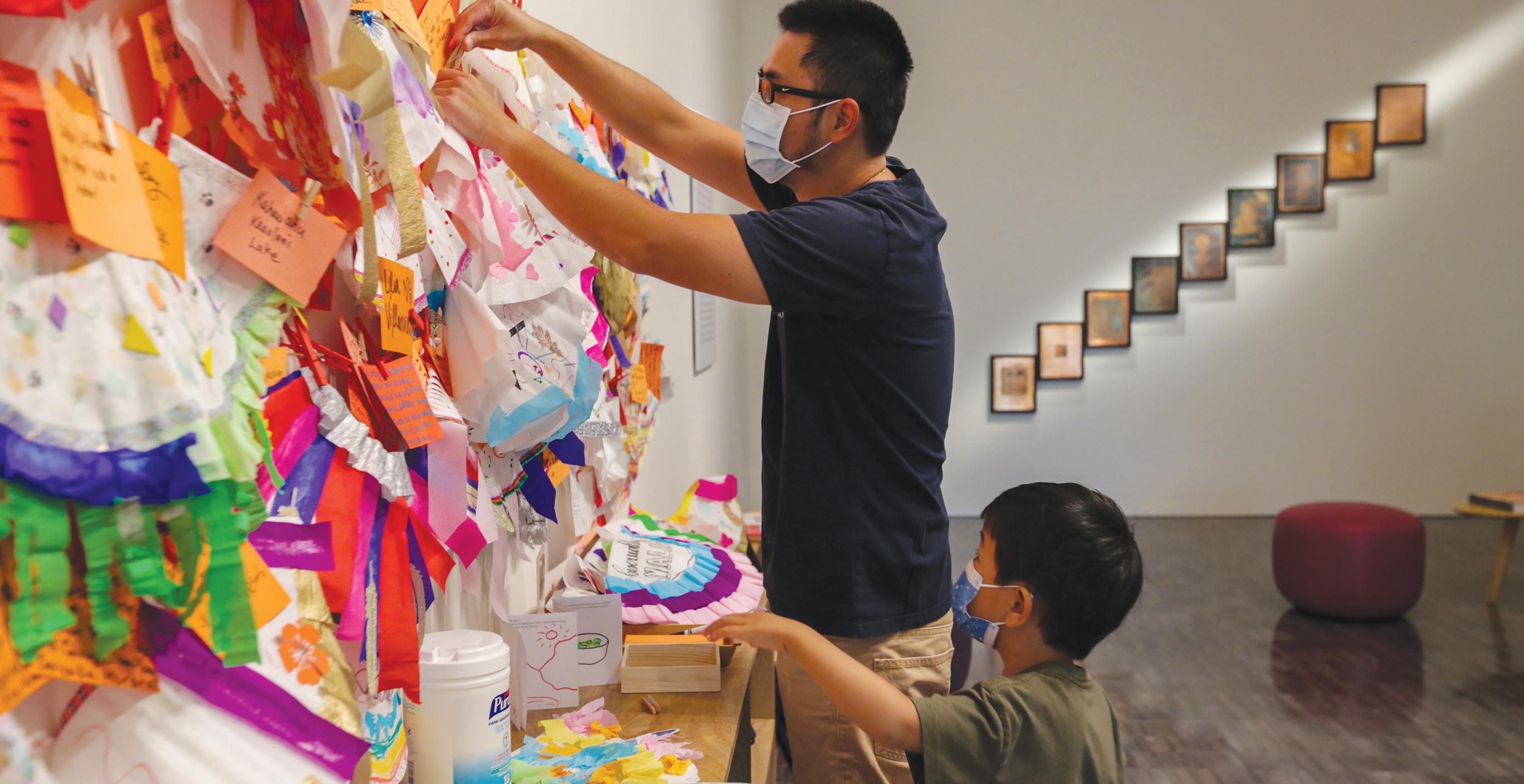
“I think art is boundless. Art has no horizon.” — Carlos Villa
This summer we were overjoyed to exhibit Carlos Villa: Worlds in Collision, the first major museum retrospective dedicated to the work of a Filipino American artist. We are invigorated by his exuberant work and enduring influence as a teacher, curator, and activist.
Our excitement continues with Into View: Bernice Bing, featuring the museum’s recent acquisition of 20 paintings and works on paper by a San Francisco original who has only recently gained broad recognition for her achievements.
These exhibitions and more demonstrate the vital role the museum plays in serving the unique cultural landscape of the Bay Area. With your help we will continue to share new exhibitions
like these with a larger, more diverse audience. Please consider donating to the Museum Fund. Your gift paves the way for groundbreaking exhibitions, public programs, and arts education that reframes the important stories of our time. Let’s inspire creative expression in our communities and preserve important history for future generations. Your generosity will make a difference. Visit give.asianart.org to learn how you can contribute to the Museum Fund via stock, donor advised fund, or corporate matching gift. ■
Donate Today! By phone at 415.581.3740 Online at give.asianart.org, onsite during your next visit, by mail to Asian Art Museum | Museum Fund, 200 Larkin St, San Francisco, CA 94102.
MEMBERSHIP FALL 2022 27
TOGETHER WE MAKE A GREAT TEAM All gifts received through December 31, 2022, are fully tax-deductible for the 2022 tax year. Photograph © Asian
Art Museum of San Francisco.
HOLIDAY ARTISAN MARKET — BIGGER AND BETTER THAN EVER

CHA MAY CHING MUSEUM BOUTIQUE
Friday, Nov 18 | 9 AM to 10 AM (members only), 10 AM to 6 PM (open to all)
Saturday, Nov 19 | 10 AM to 6 PM (open to all)
Sunday, Dec 4 | 10 AM to 6 PM (open to all)
Get all of your holiday shopping done early. Back (and expanded!) by popular demand, the Cha May Ching Museum Boutique’s Holiday Artisan Market returns, spread over two weekends, featuring dozens of local creators offering hundreds of one-ofa-kind items including:

Jewelry – from traditional sparkle to unforgettable statement Ceramics – glossy housewares and show-stopping centerpieces



Fashion & accessories – eye-catching flair and timeless chic Gifts for little ones – surprise those who still love a bedtime story
Books – hand-sewn notebooks to gorgeous prints
Specialty food products – brighten up your pantry and your palate
Ornaments – effortlessly make the season shine Cards – express your hopes and dreams in style
Admission to the Holiday Artisan Markets is free to all — tell and bring friends. Members receive 10% discount on all merchandise. ■
CHA MAY CHING MUSEUM BOUTIQUE
28 ASIAN ART MUSEUM
Visit the market for a chance to win a $100 gift certificate to the
Feeling lucky?
boutique.
SPRING 2023
ARTS OF ASIA LECTURE SERIES
GLOBAL CONNECTIONS: ASIA AND THE ARTS IN THE SECOND MILLENNIUM OF THE COMMON ERA

Join us in the Museum’s Samsung Hall or on Zoom as noted scholars come to the Asian Art Museum for 14 weeks to lecture on the arts and culture of Asia in the Second Millennium with a focus on the effects of technology and the environment.
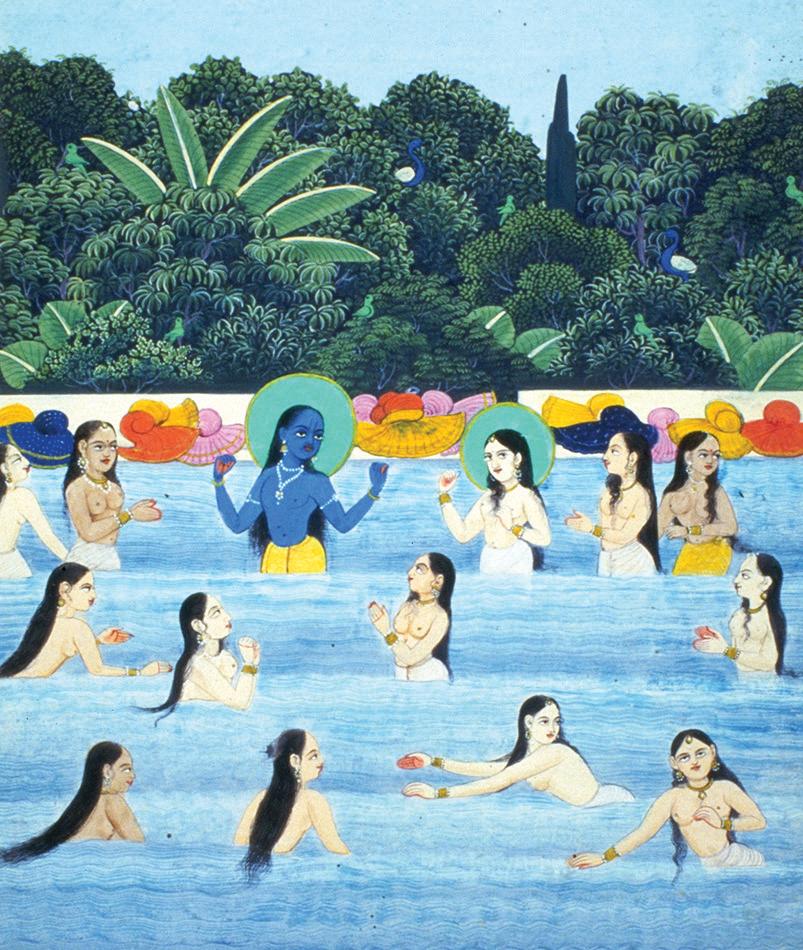
From the steppes of East Asia, explore the impact of the Mongol empire from a uniquely Mongolian viewpoint as the empire expands west, forming the Ilkhanid dynasty in Persia and the Yuan dynasty in China. Follow the Ottoman empire as it expands from its center in Bursa and Constantinople. Claiming the legitimacy of their Mongol ancestors, the Mughals established an empire in India in the 16th century. This period coincided with climatic upheavals known as the Little Ice Age (1550–1850) and profoundly impacted both Indian religion and
Left: Bowl with
approx. 1250–1350.
B60P1908.
technology. Climate and geography also affected the rise of empires in Southeast Asia and triggered conflicts in the strategic location of the Korean Peninsula. We will study world views through different cultural lenses of geomancy and Zen. We will conclude with the beginnings of a great global sea trade based on an expanding market economy.
Lectures will be held on Fridays, 10:30 AM to 12:30 PM, from January 27 through April 28, 2023. For registration information and a full list of speakers and topics, please visit the Society for Asian Art website. ■
SOCIETYFORASIANART.ORG
SOCIETY FOR ASIAN ART
running rabbit,
Iran; probably Kashan. Ilkhanid period (1256–1353). Glazed fritware with underglaze decoration. Asian Art Museum, The Avery Brundage Collection,
Photograph © Asian Art Museum. Right: The Hindu deity Krishna bathing with female cowherds, approx. 1820. India. Opaque watercolors on paper. Asian Art Museum, Gift of Mr. and Mrs. George Hopper Fitch, 1988.51.21. Photograph © Asian Art Museum.
FALL 2022 29
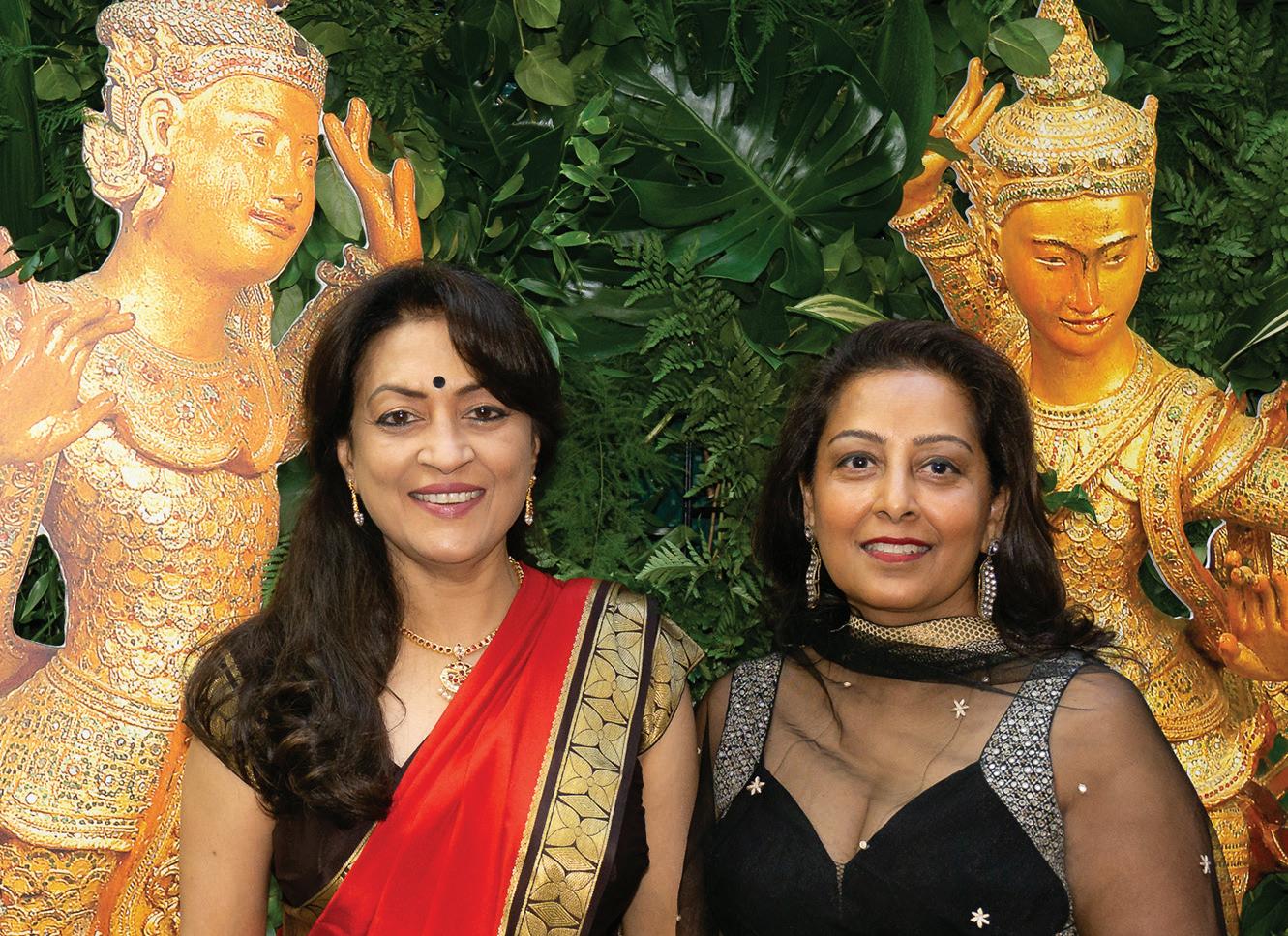


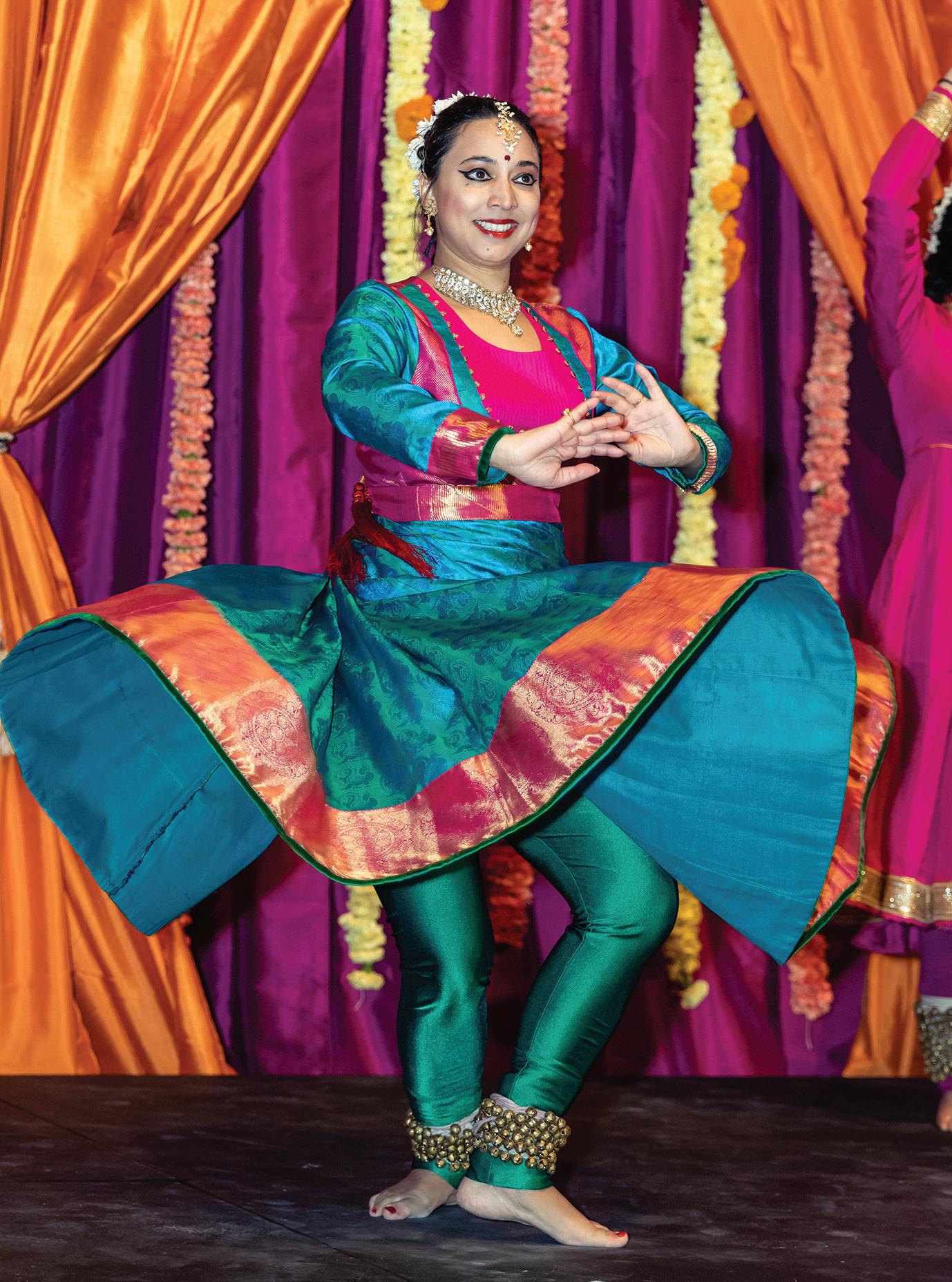
1 1 3 2 30 ASIAN ART MUSEUM 4 SCENE AT THE ASIAN
SCENE AT THE ASIAN
There was lots to be seen onsite this spring and summer — from live musical performances and community karaoke, to celebrations of new exhibitions, sneak peeks of forthcoming shows, and festive fundraisers to ensure exciting programs after the new year. n
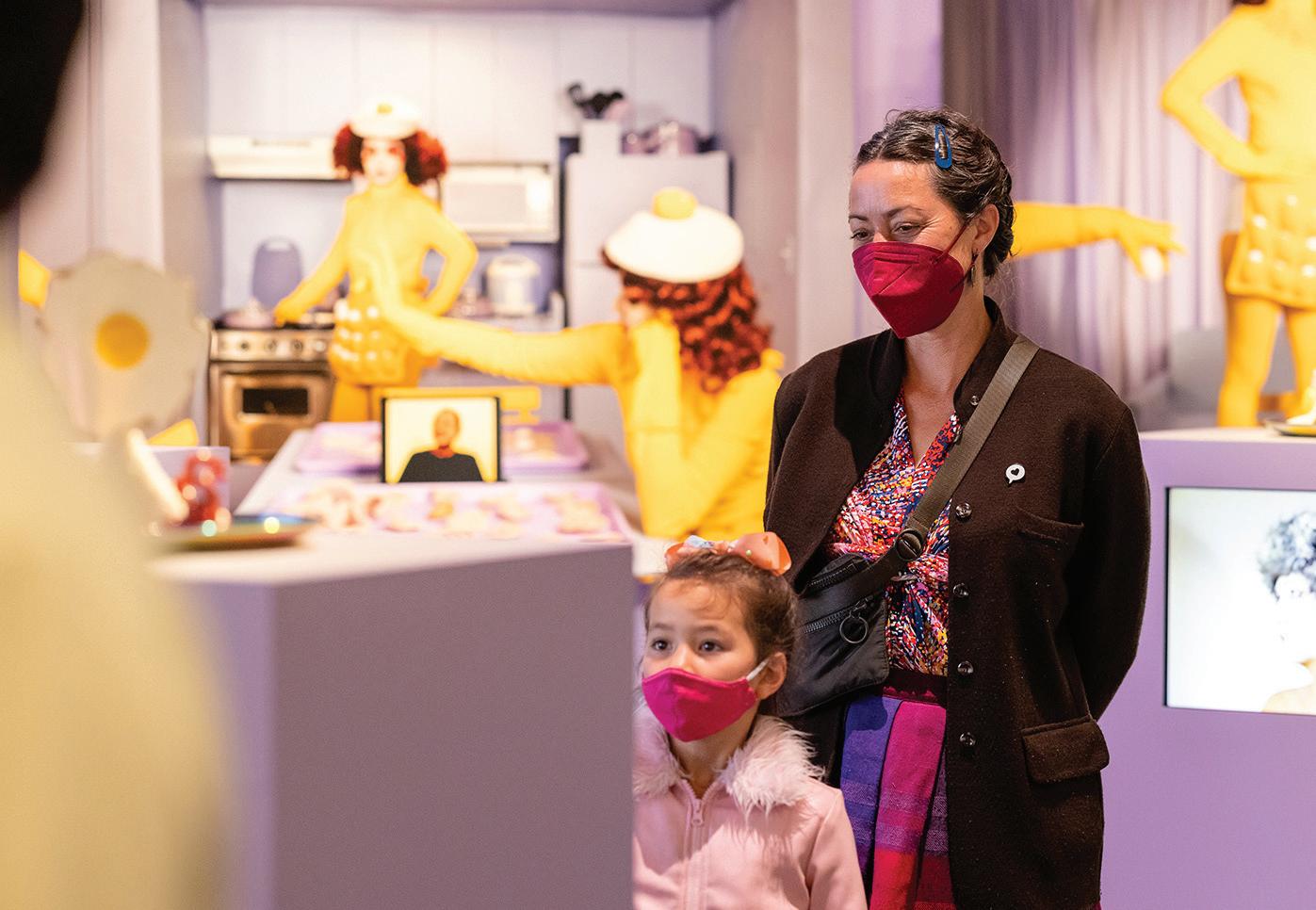
Thank you Vaishali Chadha (left) Lata Krishnan (right) and Anjali Pichai (not pictured) for planning the successful fundraiser to support next spring’s exhibition Beyond Bollywood: 2000 Years of Dance
Labonee Mohanta performed kathak classical Indian dance at the Beyond Bollywood: 2000 Years of Dance fundraising event.
(Left to right) Artist Michael Arceaga, exhibition co-curator Trisha Lagaso Goldberg, and Eliza O. Barrios, Reanne Estrada, and Jenifer K Wofford, of the artist collective Mail Order Brides/M.O.B., celebrate Carlos Villa. Photograph by Katelyn Tucker.
A guest in a groove at An Evening of Karaoke and Community Sing-Along.
Guests welcomed Carlos Villa: Worlds in Collision at the members preview. Photograph by Katelyn Tucker.
At Sound/scapes, cellist and vocalist Theresa Wong performed new work inspired by artworks in the collection.

At the Annual Preview Luncheon, members got a first glimpse of upcoming exhibitions while enjoying lunch with the Barbara Bass Director and CEO Dr. Jay Xu and curators. Photograph by Katelyn Tucker.

FALL 2022 31
6 1 2 3 4 5 6 7 7 5 SCENE AT THE ASIAN
FEATURED EVENTS
6 / TUESDAY
All programs are free for museum members. Details subject to change. Please visit asianart.org for updates.
ONGOING
DAILY
The Intersection in the Shriram Experiential Learning Center, an Interactive Space for Drop-in Art Making On-site at the museum
DAILY
Draw with Reina Activity Pack On-site at the museum Pick up at the information desk
DAILY
Art Cards Self-Guided Gallery Activity On-site at the museum Pick up at the information desk
FRIDAYS, SATURDAYS, AND SUNDAYS
Docent Tours: Great Works of the Asian Art Museum 2:00 PM On-site at the museum
THURSDAYS
Contemporary Thursday tours 2 PM
On-site at the museum
NOVEMBER
22 / TUESDAY
Takeout Tuesdays: Lunchtime
Conversations About Art 12–12:45 PM Online via Zoom
29 / TUESDAY
Takeout Tuesdays: Lunchtime
Conversations About Art 12–12:45 PM Online via Zoom
DECEMBER
4 / SUNDAY
Family Fun Day and Storytelling
11 AM–2:30 PM
On-site at the museum
Takeout Tuesdays: Lunchtime Conversations About Art 12–12:45 PM Online via Zoom
13 / TUESDAY
Takeout Tuesdays: Lunchtime Conversations About Art 12–12:45 PM Online via Zoom
15 / THURSDAY
Conversation about Hodaka Prints with Ayomi Yoshida 2–3:30 PM On-site at the museum

20 / TUESDAY
Takeout Tuesdays: Lunchtime Conversations About Art 12–12:45 PM Online via Zoom
27 / TUESDAY
Takeout Tuesdays: Lunchtime Conversations About Art 12–12:45 PM Online via Zoom
31 / SATURDAY
37th Annual Bell Ringing Ceremony 9:30–11 AM Members 11:30 AM–1:30 PM General Public On-site at the museum
JANUARY
3 / TUESDAY
Takeout Tuesdays: Lunchtime Conversations About Art 12–12:45 PM Online via Zoom
8 / SUNDAY
Family Fun Day and Storytelling 11 AM–2:30 PM On-site at the museum
10 / TUESDAY
Takeout Tuesdays: Lunchtime Conversations About Art 12–12:45 PM Online via Zoom
17 / TUESDAY
Takeout Tuesdays: Lunchtime Conversations About Art 12–12:45 PM Online via Zoom
24 / TUESDAY
Takeout Tuesdays: Lunchtime Conversations About Art 12–12:45 PM Online via Zoom
FEBRUARY
5 / SUNDAY
Lunar New Year Family Fun Day and Storytelling 11 AM–2:30 PM On-site at the museum
11 / SATURDAY
The Worlds of Bernice Bing Film Screening and Panel Discussion 1–2:30 PM On-site at the museum
14 / TUESDAY
Takeout Tuesdays: Lunchtime Conversations About Art 12–12:45 PM Online via Zoom
21 / TUESDAY
Takeout Tuesdays: Lunchtime Conversations About Art 12–12:45 PM Online via Zoom
28 / TUESDAY
Takeout Tuesdays: Lunchtime Conversations About Art 12–12:45 PM Online via Zoom
EVENT CALENDAR
Online via Zoom
32 ASIAN ART MUSEUM
Mel VeraCruz live painting at the recent Sonic Worlds in Collision Dance Party in celebration of Carlos Villa. Photograph © Asian Art Museum.
FEATURED MEMBER EVENTS
All events are free for members unless noted. Visit calendar.asianart. org to stay up to date on all of our wonderful member events. Make sure you’re subscribed to the member e-news to receive evites and updates throughout the year. Contact members@asianart.org to update your contact information.
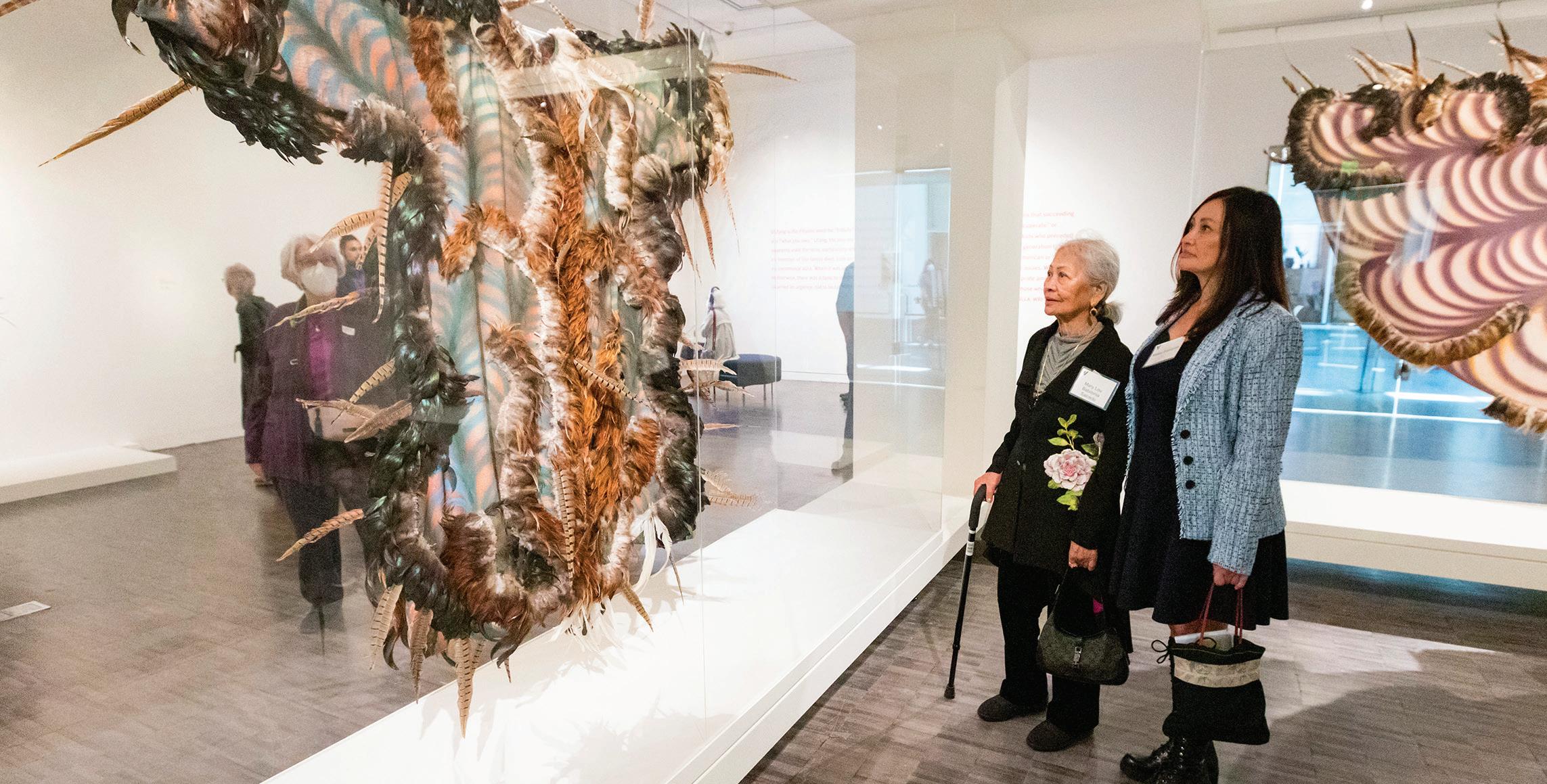
DECEMBER
14 / WEDNESDAY
Jade: Stone of Heaven Virtual Lecture Series
10–11:30 AM
Open to all members Online via Zoom
15 / THURSDAY
Curator’s Choice Lecture
Color Trip with Yuki Morishima
Preview of Color Trip: Yoshida Hodaka’s Modern Prints 2:30 PM
Patron and Friend members On-site at the museum
31 / SATURDAY
37th Annual Bell Ringing Ceremony
9:30–11 AM Members 11:30 AM–1:30 PM General public On-site at the museum
JANUARY
11 / WEDNESDAY
Lunar New Year: Year of the Rabbit Virtual Lecture Series 10–11:30 AM
Open to all members Online via Zoom
FEBRUARY
8 / WEDNESDAY
Woodblock Prints
Virtual Lecture Series 10 AM Open to all members
MUSEUM HOURS
Thu 1–8 PM (Nov, Jan, Feb); 10–5 PM (Dec only)
Fri–Mon 10 AM–5 PM
NEW MUSEUM HOURS
Tue & Wed Closed
Visit asianart.org for additional closings and special hours. Please check calendar.asianart.org for
asianart.org @asianartmuseum
EVENT CALENDAR
2022 ASIAN ART MUSEUM
FALL
Supporters Mary Lou Salcedo and Malou Babilonia enjoy a preview of Carlos Villa: Worlds in Collision. Photograph by Michael O’Donnell for Ian Chin Photography.
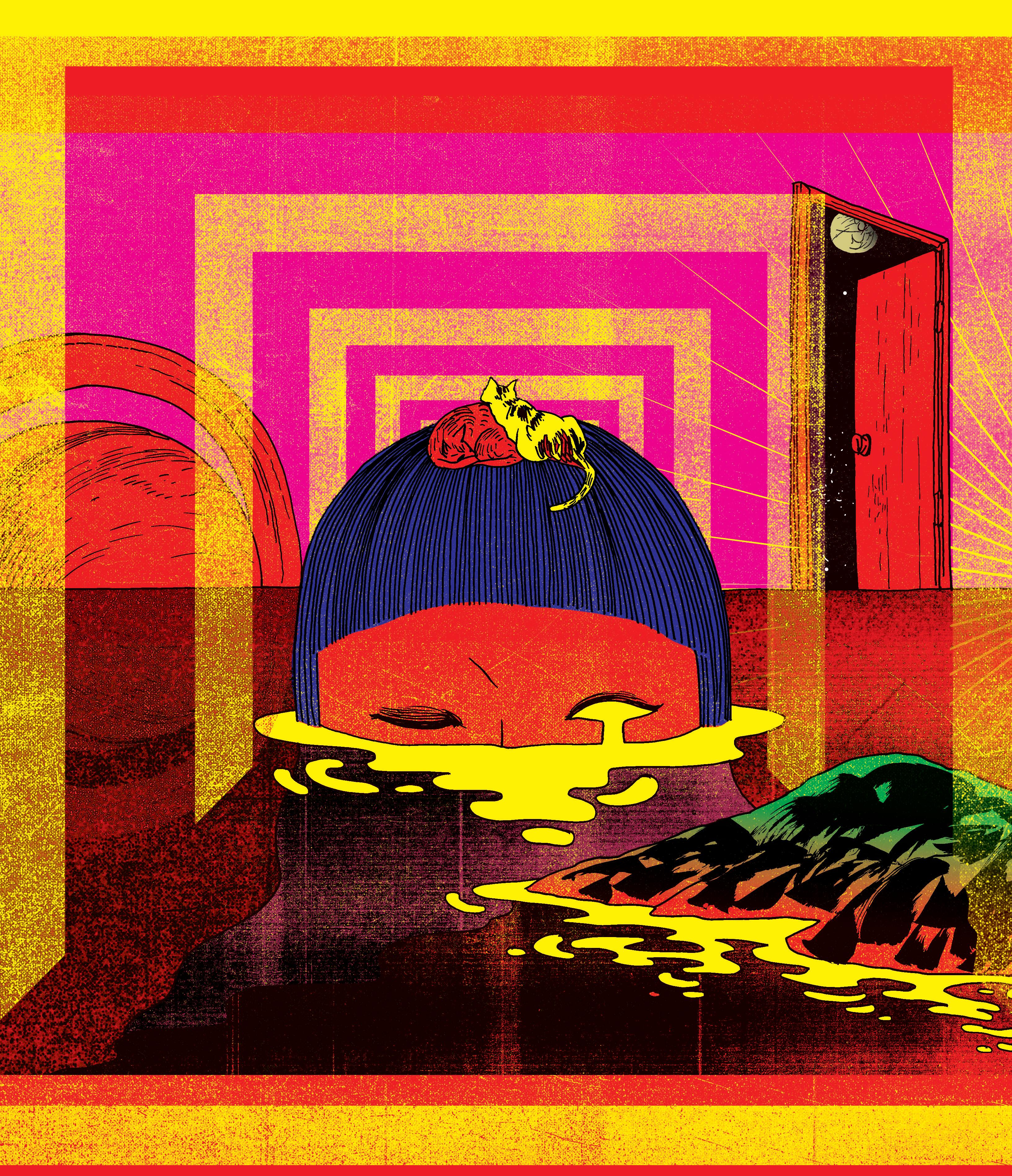
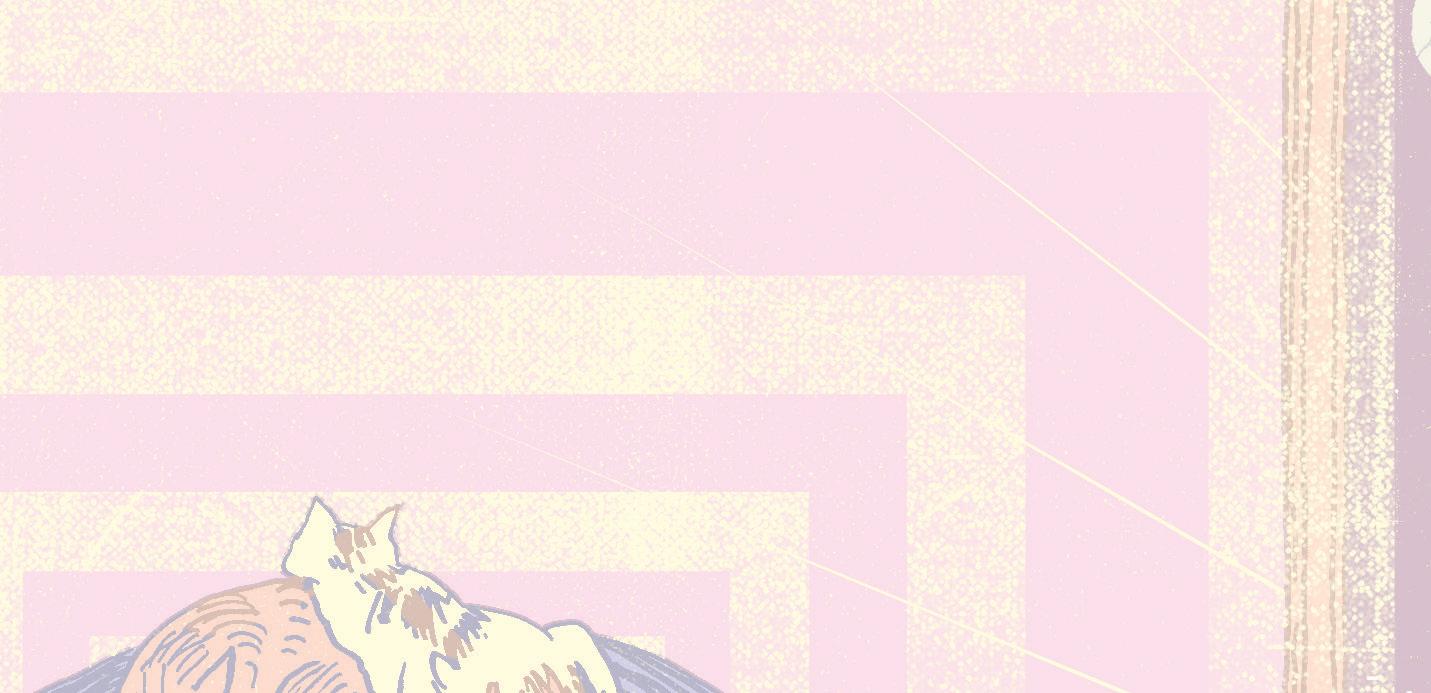

 Non-Profit Organization U.S. Postage PAID Asian Art Museum of San Francisco
ASIAN ART MUSEUM Chong-Moon Lee Center for Asian Art & Culture asianart.org 200 Larkin Street San Francisco, CA 94102 USA
Non-Profit Organization U.S. Postage PAID Asian Art Museum of San Francisco
ASIAN ART MUSEUM Chong-Moon Lee Center for Asian Art & Culture asianart.org 200 Larkin Street San Francisco, CA 94102 USA







 THE BARBARA BASS BAKAR DIRECTOR AND CEO
THE BARBARA BASS BAKAR DIRECTOR AND CEO





























 Kongkee: Warring States Cyberpunk is organized by the Asian Art Museum of San Francisco. Presentation is made possible with the generous support of the Barbara Bass Bakar, HSBC Bank USA, and Diane B. Wilsey.
Kongkee: Warring States Cyberpunk is organized by the Asian Art Museum of San Francisco. Presentation is made possible with the generous support of the Barbara Bass Bakar, HSBC Bank USA, and Diane B. Wilsey.








 Beyond Bollywood: 2000 Years of Dance in Art is co-organized by the Asian Art Museum of San Francisco and the Cincinnati Art Museum. This exhibition has been made possible in part by a major grant from the National Endowment for the Humanities: Democracy demands wisdom. Additional support provided by Eliza and Dean Cash, Sumir Chadha, Vaishali Chadha and Family, Yogen and Peggy Dalal, Shashi and Dipanjan “DJ” Deb, Aarti and Sandeep Johri, Lata Krishnan and Ajay B. Shah, Fred Levin & Salle Yoo and Je Gray, Dipti and Rakesh Mathur, Sundar and Anjali Pichai, SACHI, Society for Art & Cultural Heritage of India, Ram and Vijay Shriram, Meena Vashee, and an anonymous donor.
Beyond Bollywood: 2000 Years of Dance in Art is co-organized by the Asian Art Museum of San Francisco and the Cincinnati Art Museum. This exhibition has been made possible in part by a major grant from the National Endowment for the Humanities: Democracy demands wisdom. Additional support provided by Eliza and Dean Cash, Sumir Chadha, Vaishali Chadha and Family, Yogen and Peggy Dalal, Shashi and Dipanjan “DJ” Deb, Aarti and Sandeep Johri, Lata Krishnan and Ajay B. Shah, Fred Levin & Salle Yoo and Je Gray, Dipti and Rakesh Mathur, Sundar and Anjali Pichai, SACHI, Society for Art & Cultural Heritage of India, Ram and Vijay Shriram, Meena Vashee, and an anonymous donor.




























































 Non-Profit Organization U.S. Postage PAID Asian Art Museum of San Francisco
ASIAN ART MUSEUM Chong-Moon Lee Center for Asian Art & Culture asianart.org 200 Larkin Street San Francisco, CA 94102 USA
Non-Profit Organization U.S. Postage PAID Asian Art Museum of San Francisco
ASIAN ART MUSEUM Chong-Moon Lee Center for Asian Art & Culture asianart.org 200 Larkin Street San Francisco, CA 94102 USA